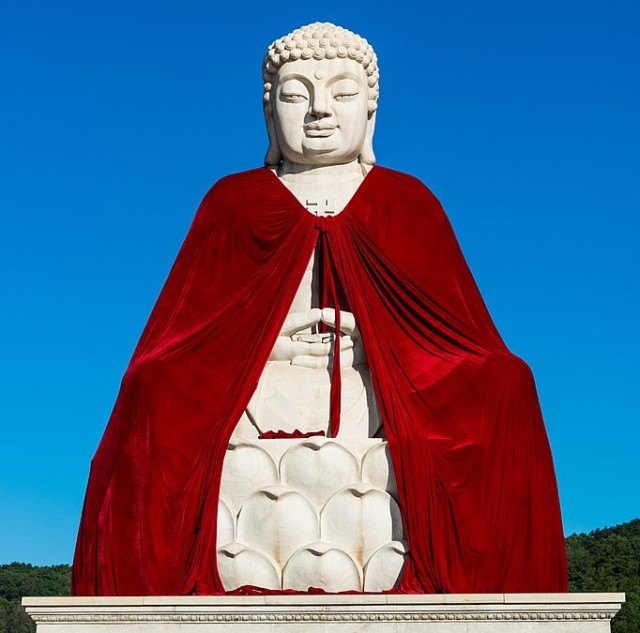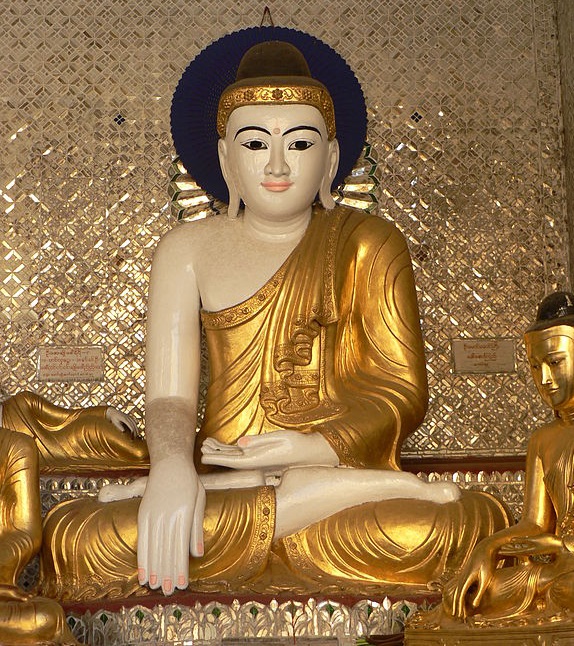
| GAUTAM BUDDH
A statue of the Buddh from Sarnath, Uttar Pradesh, India, circa 475 CE. The Buddh is depicted teaching in the lotus position, while making the Dharmacakra mudra Gautam Buddh
Sanskrit name : Siddharth Gautam
Pali name : Siddhatth Gotam
Other names : Shakyamuni ("Sage of the Shakyas")
Personal
Born
c. 563 BCE or 480 BCE : Lumbini, Shakya Republic (according to Buddhist tradition)
Died
c. 563 BCE or 480 BCE : Lumbini, Shakya Republic (according to Buddhist tradition)
Religion : Buddhism
Spouse : Yasodhara
Children :
Parents : Suddhodan (father) and Maya Devi (mother)
Known for : Founder of Buddhism
Predecessor : Kassap Buddh
Successor : Maitreya
The Buddh (also known as Siddharth Gotam or Siddharth Gautam or Buddh Shakyamuni) was a philosopher, mendicant, meditator, spiritual teacher, and religious leader who lived in Ancient India (c. 5th to 4th century BCE). He is revered as the founder of the world religion of Buddhism, and worshipped by most Buddhist schools as the Enlightened One who has transcended Karma and escaped the cycle of birth and rebirth. He taught for around 45 years and built a large following, both monastic and lay. His teaching is based on his insight into dukh (typically translated as "suffering") and the end of dukh– the state called Nibban or Nirvan.
The Buddh was born into an aristocratic family in the Shakya (shak / saka) clan but eventually renounced lay life. According to Buddhist tradition, after several years of mendicancy, meditation, and asceticism, he awakened to understand the mechanism which keeps people trapped in the cycle of rebirth. The Buddh then traveled throughout the Ganges plain teaching and building a religious community. The Buddh taught a middle way between sensual indulgence and the severe asceticism found in the Indian sraman movement. He taught a spiritual path that included ethical training and meditative practices such as jhana and mindfulness.
A couple of centuries after his death he came to be known by the title Buddh, which means "Awakened One" or "Enlightened One". Gautam's teachings were compiled by the Buddhist community in the Suttas, which contain his discourses, and the Vinaya, his codes for monastic practice. These were passed down in Middle-Indo Aryan dialects through an oral tradition. Later generations composed additional texts, such as systematic treatises known as Abhidharma, biographies of the Buddh, collections of stories about the Buddh's past lives known as Jatak tales, and additional discourses, i.e, the Mahayan sutras.
Names
and titles :
In the early texts, the Buddh also often refers to himself as Tathagata. The term is often thought to mean either "one who has thus gone" (tatha-gata) or "one who has thus come" (tatha-agata), possibly referring to the transcendental nature of the Buddh's spiritual attainment.
A common list of epithets are commonly seen together in the canonical texts, and depict some of his spiritual qualities :
•
Sammasambuddho
– Perfectly self-awakened
Historical
person :
The times of Gautam's birth and death are uncertain. Most historians in the early 20th century dated his lifetime as c. 563 BCE to 483 BCE. Within the Eastern Buddhist tradition of China, Vietnam, Korea and Japan, the traditional date for the death of the Buddh was 949 B.C. According to the Ka-tan system of time calculation in the Kalachakra tradition, Buddh is believed to have died about 833 BCE. More recently his death is dated later, between 411 and 400 BCE, while at a symposium on this question held in 1988, the majority of those who presented definite opinions gave dates within 20 years either side of 400 BCE for the Buddh's death. These alternative chronologies, however, have not been accepted by all historians.
Historical context :
Ancient kingdoms and cities of India during the time of the Buddh (circa 500 BCE) According to the Buddhist tradition, Gautam was born in Lumbini, now in modern-day Nepal, and raised in Kapilvastu, which may have been either in what is present-day Tilaurakot, Nepal or Piprahwa, India. According to Buddhist tradition, he obtained his enlightenment in Bodh Gaya, gave his first sermon in Sarnath, and died in Kushinagar.
One of Gautam's usual names was "Shakmuni" or "Sakyamuni" ("Sage of the Shakyas"). This and the evidence of the early texts suggests that he was born into the Shakya clan, a community that was on the periphery, both geographically and culturally, of the eastern Indian subcontinent in the 5th century BCE. The community was either a small republic, or an oligarchy. His father was an elected chieftain, or oligarch. Bronkhorst calls this eastern culture Greater Magadh and notes that "Buddhism and Jainism arose in a culture which was recognized as being non-Vedic".
The Shakyas were an eastern sub-Himalayan ethnic group who were considered outside of the Aryavart and of ‘mixed origin’ (samkirn-yonayah, possibly part Aryan and part indigenous). The laws of Manu treats them as being non Aryan. As noted by Levman, "The Baudhayan-dharmashastra (1.1.2.13–4) lists all the tribes of Magadh as being outside the pale of the Aryavart; and just visiting them required a purificatory sacrifice as expiation" (In Manu 10.11, 22). This is confirmed by the Ambattha Sutta, where the Sakyans are said to be "rough-spoken", "of menial origin" and criticised because "they do not honour, respect, esteem, revere or pay homage to Brahmans." Some of the non-Vedic practices of this tribe included incest (marrying their sisters), the worship of trees, tree spirits and nagas. According to Levman "while the Sakyans’ rough speech and Munda ancestors do not prove that they spoke a non-Indo-Aryan language, there is a lot of other evidence suggesting that they were indeed a separate ethnic (and probably linguistic) group." Christopher I. Beckwith identifies the Shakyas as Scythians.
Apart from the Vedic Brahmins, the Buddh's lifetime coincided with the flourishing of influential Sraman schools of thought like Ajivika, Carvaka, Jainism, and Ajñana. Brahmajal Sutta records sixty-two such schools of thought. In this context, a sraman refers to one who labors, toils, or exerts themselves (for some higher or religious purpose). It was also the age of influential thinkers like Mahavir, Puran Kassap, Makkhali Gosal, Ajita Kesakambali, Pakudha Kaccayana, and Sañjaya Belatthaputta, as recorded in Samaññaphala Sutta, whose viewpoints the Buddh most certainly must have been acquainted with. Indeed, Sariputra and Moggallana, two of the foremost disciples of the Buddh, were formerly the foremost disciples of Sañjaya Belatthaputta, the sceptic; and the Pali canon frequently depicts Buddh engaging in debate with the adherents of rival schools of thought. There is also philological evidence to suggest that the two masters, Alara Kalama and Uddaka Ramaputta, were indeed historical figures and they most probably taught Buddh two different forms of meditative techniques. Thus, Buddh was just one of the many sraman philosophers of that time. In an era where holiness of person was judged by their level of asceticism, Buddh was a reformist within the sraman movement, rather than a reactionary against Vedic Brahminism.
Historically, the life of the Buddh also coincided with the Achaemenid conquest of the Indus Valley during the rule of Darius I from about 517/516 BCE. This Achaemenid occupation of the areas of Gandhar and Sindh, which lasted about two centuries, was accompanied by the introduction of Achaemenid religions, reformed Mazdaism or early Zoroastrianism, to which Buddhism might have in part reacted. In particular, the ideas of the Buddh may have partly consisted of a rejection of the "absolutist" or "perfectionist" ideas contained in these Achaemenid religions.
Earliest sources :
No written records about Gautam were found from his lifetime or from the one or two centuries thereafter. But from the middle of the 3rd century BCE, several Edicts of Ashok (reigned c. 269–232 BCE) mention the Buddh, and particularly Ashok's Lumbini pillar inscription commemorates the Emperor's pilgrimage to Lumbini as the Buddh's birthplace, calling him the Buddh Shakyamuni (Brahmi script: Bu-dha Sa-kya-mu-ni, "Buddh, Sage of the Shakyas"). Another one of his edicts (Minor Rock Edict No. 3) mentions the titles of several Dhamma texts (in Buddhism, "dhamma" is another word for "dharma"), establishing the existence of a written Buddhist tradition at least by the time of the Maurya era. These texts may be the precursor of the Pali Canon.
Bharhut inscription: Bhagavato Sakamunino Bodho ("The illumination of the Blessed Sakamuni"), circa 100 BCE "Sakamuni" is also mentioned in the reliefs of Bharhut, dated to circa 100 BCE, in relation with his illumination and the Bodhi tree, with the inscription Bhagavato Sakamunino Bodho ("The illumination of the Blessed Sakamuni").
The oldest surviving Buddhist manuscripts are the Gandharan Buddhist texts, found in Afghanistan and written in Gandhari, they date from the first century BCE to the third century CE.
On the basis of philological evidence, Indologist and Pali expert Oskar von Hinüber says that some of the Pali suttas have retained very archaic place-names, syntax, and historical data from close to the Buddh's lifetime, including the Mahaparinibban Sutta which contains a detailed account of the Buddh's final days. Hinüber proposes a composition date of no later than 350–320 BCE for this text, which would allow for a "true historical memory" of the events approximately 60 years prior if the Short Chronology for the Buddh's lifetime is accepted (but he also points out that such a text was originally intended more as hagiography than as an exact historical record of events).
John S. Strong sees certain biographical fragments in the canonical texts preserved in Pali, as well as Chinese, Tibetan and Sanskrit as the earliest material. These include texts such as the “Discourse on the Noble Quest” (Pali: Ariyapariyesana-sutta) and its parallels in other languages.
Traditional biographies :
One of the earliest anthropomorphic representations of the Buddh, here surrounded by Brahma (left) and Sakra (right). Bimaran Casket, mid-1st century CE, British Museum
Biographical sources :
The earlier canonical sources include the Ariyapariyesana Sutta (MN 26), the Mahaparinibban Sutt (DN 16), the Mahasaccak-sutt (MN 36), the Mahapadan Sutt (DN 14), and the Achariyabhut Sutt (MN 123), which include selective accounts that may be older, but are not full biographies. The Jatak tales retell previous lives of Gautam as a bodhisattva, and the first collection of these can be dated among the earliest Buddhist texts. The Mahapadan Sutt and Achariyabhut Sutt both recount miraculous events surrounding Gautam's birth, such as the bodhisattva's descent from the Tu?ita Heaven into his mother's womb.
Nature of traditional depictions :
Maya miraculously giving birth to Siddharth. Sanskrit, palm-leaf manuscript. Nalanda, Bihar, India. Pal period In the earliest Buddhist texts, the nikayas and agamas, the Buddh is not depicted as possessing omniscience (sabbaññu) nor is he depicted as being an eternal transcendent (lokottara) being. According to Bhikkhu Analayo, ideas of the Buddh's omniscience (along with an increasing tendency to deify him and his biography) are found only later, in the Mahayan sutras and later Pali commentaries or texts such as the Mahavastu. In the Sandak Sutt, the Buddh's disciple Anand outlines an argument against the claims of teachers who say they are all knowing while in the Tevijjavacchagotta Sutta the Buddh himself states that he has never made a claim to being omniscient, instead he claimed to have the "higher knowledges" (abhijña). The earliest biographical material from the Pali Nikayas focuses on the Buddh's life as a sraman, his search for enlightenment under various teachers such as Alara Kalama and his forty-five-year career as a teacher.
Traditional biographies of Gautam often include numerous miracles, omens, and supernatural events. The character of the Buddh in these traditional biographies is often that of a fully transcendent (Skt. lokottar) and perfected being who is unencumbered by the mundane world. In the Mahavastu, over the course of many lives, Gautam is said to have developed supramundane abilities including: a painless birth conceived without intercourse; no need for sleep, food, medicine, or bathing, although engaging in such "in conformity with the world"; omniscience, and the ability to "suppress karma". As noted by Andrew Skilton, the Buddh was often described as being superhuman, including descriptions of him having the 32 major and 80 minor marks of a "great man," and the idea that the Buddh could live for as long as an aeon if he wished (see DN 16).
The ancient Indians were generally unconcerned with chronologies, being more focused on philosophy. Buddhist texts reflect this tendency, providing a clearer picture of what Gautam may have taught than of the dates of the events in his life. These texts contain descriptions of the culture and daily life of ancient India which can be corroborated from the Jain scriptures, and make the Buddh's time the earliest period in Indian history for which significant accounts exist. British author Karen Armstrong writes that although there is very little information that can be considered historically sound, we can be reasonably confident that Siddharth Gautam did exist as a historical figure. Michael Carrithers goes a bit further by stating that the most general outline of "birth, maturity, renunciation, search, awakening and liberation, teaching, death" must be true.
Previous lives :
The
legendary Jatak collections depict the Buddh-to-be in a previous
life prostrating before the past Buddh Dipankar, making a resolve
to be a Buddh, and receiving a prediction of future Buddhhood.
Besides imbuing the pre-Buddhist past with a deep karmic history, the Jataks also serve to explain the bodhisattva's (the Buddh-to-be) path to Buddhhood. In biographies like the Buddahvansa, this path is described as long and arduous, taking "four incalculable ages" (asamkheyyas).
In these legendary biographies, the bodhisattva goes through many different births (animal and human), is inspired by his meeting of past Buddhs, and then makes a series of resolves or vows (pranidhana) to become a Buddh himself. Then he begins to receive predictions by past Buddhs. One of the most popular of these stories is his meeting with Dipankar Buddh, who gives the bodhisattva a prediction of future Buddhhood.
Another theme found in the Pali Jatak Commentary (Jatakatthakatha) and the Sanskrit Jatakamala is how the Buddh-to-be had to practice several "perfections" (paramit) to reach Buddhhood. The Jataks also sometimes depict negative actions done in previous lives by the bodhisattva, which explain difficulties he experienced in his final life as Gautam.
Biography
:
Map showing Lumbini and other major Buddhist sites in India. Lumbini (present-day Nepal), is the birthplace of the Buddh, and is a holy place also for many non-Buddhists.
The Lumbini pillar contains an inscription stating that this is the Buddh's birthplace The Buddhist tradition regards Lumbini, in present-day Nepal to be the birthplace of the Buddh. He grew up in Kapilavastu. The exact site of ancient Kapilavastu is unknown. It may have been either Piprahwa, Uttar Pradesh, in present-day India, or Tilaurakot, in present-day Nepal. Both places belonged to the Sakya territory, and are located only 15 miles (24 km) apart.
The earliest Buddhist sources state that the Buddh was born to an aristocratic Kshatriya (Pali: khattiya) family called Gotama (Sanskrit: Gautam), who were part of the Shakyas, a tribe of rice-farmers living near the modern border of India and Nepal. the son of Suddhodan, "an elected chief of the Shakya clan", whose capital was Kapilavastu, and who were later annexed by the growing Kingdom of Koshal during the Buddh's lifetime. Gautam was the family name. According to later biographies such as the Mahavastu and the Lalitavistara, his mother, Maya (Mayadevi), Suddhodan's wife, was a Koliyan princess. Legend has it that, on the night Siddharth was conceived, Queen Maya dreamt that a white elephant with six white tusks entered her right side, and ten months later Siddharth was born. As was the Shakya tradition, when his mother Queen Maya became pregnant, she left Kapilavastu for her father's kingdom to give birth. However, her son is said to have been born on the way, at Lumbini, in a garden beneath a sal tree.
The early Buddhist texts contain very little information about the birth and youth of Gotam Buddh. Later biographies developed a dramatic narrative about the life of the young Gotam as a prince and his existential troubles. They also depict his father Suddhodan as a hereditary monarch of the Suryavansh (Solar dynasty) of Iksvaku (Pali: Okkaka). This is unlikely however, as many scholars think that Suddhodana was merely a Shakya aristocrat (khattiya), and that the Shakya republic was not a hereditary monarchy. Indeed, the more egalitarian gana-sangha form of government, as a political alternative to Indian monarchies, may have influenced the development of the sramanic Jain and Buddhist sanghas, where monarchies tended toward Vedic Brahmanism.
The day of the Buddh's birth is widely celebrated in Theravad countries as Vesak. Buddh's Birthday is called Buddh Purnima in Nepal, Bangladesh, and India as he is believed to have been born on a full moon day.
According to later biographical legends, during the birth celebrations, the hermit seer Asit journeyed from his mountain abode, analyzed the child for the "32 marks of a great man" and then announced that he would either become a great king (chakravartin) or a great religious leader. Suddhodan held a naming ceremony on the fifth day and invited eight Brahmin scholars to read the future. All gave similar predictions. Kondañña, the youngest, and later to be the first arhat other than the Buddh, was reputed to be the only one who unequivocally predicted that Siddharth would become a Buddh.
Early texts suggest that Gautam was not familiar with the dominant religious teachings of his time until he left on his religious quest, which is said to have been motivated by existential concern for the human condition. According to the early Buddhist Texts of several schools, and numerous post-canonical accounts, Gotam had a wife, Yasodhara, and a son, named Rahul. Besides this, the Buddh in the early texts reports that "'I lived a spoilt, a very spoilt life, monks (in my parents’ home)."
The legendary biographies like the Lalitavistar also tell stories of young Gotam's great martial skill, which was put to the test in various contests against other Shakyan youths.
Renunciation :
While the earliest sources merely depict Gotam seeking a higher spiritual goal and becoming an ascetic or sraman after being disillusioned with lay life, the later legendary biographies tell a more elaborate dramatic story about how he became a mendicant.
The earliest accounts of the Buddh's spiritual quest is found in texts such as the Pali Ariyapariyesan-sutt ("The discourse on the noble quest," MN 26) and its Chinese parallel at MA 204. These texts report that what led to Gautam's renunciation was the thought that his life was subject to old age, disease and death and that there might be something better (i.e. liberation, nirvana). The early texts also depict the Buddh's explanation for becoming a sramana as follows: "The household life, this place of impurity, is narrow - the samana life is the free open air. It is not easy for a householder to lead the perfected, utterly pure and perfect holy life." MN 26, MA 204, the Dharmaguptak Vinaya and the Mahavastu all agree that his mother and father opposed his decision and "wept with tearful faces" when he decided to leave.
Prince Siddharth shaves his hair and becomes a sramana. Borobudur, 8th century Legendary biographies also tell the story of how Gautam left his palace to see the outside world for the first time and how he was shocked by his encounter with human suffering. The legendary biographies depict Gautam's father as shielding him from religious teachings and from knowledge of human suffering, so that he would become a great king instead of a great religious leader. In the Nidanakatha (5th century CE), Gautam is said to have seen an old man. When his charioteer Chandak explained to him that all people grew old, the prince went on further trips beyond the palace. On these he encountered a diseased man, a decaying corpse, and an ascetic that inspired him. This story of the "four sights" seems to be adapted from an earlier account in the Digha Nikaya (DN 14.2) which instead depicts the young life of a previous Buddh, Vipassi.
The legendary biographies depict Gautam's departure from his palace as follows. Shortly after seeing the four sights, Gautam woke up at night and saw his female servants lying in unattractive, corpse-like poses, which shocked him. Therefore, he discovered what he would later understand more deeply during his enlightenment: suffering and the end of suffering. Moved by all the things he had experienced, he decided to leave the palace in the middle of the night against the will of his father, to live the life of a wandering ascetic. Accompanied by Chandak and riding his horse Kanthak, Gautam leaves the palace, leaving behind his son Rahul and Yasodhara. He traveled to the river Anomiya, and cut off his hair. Leaving his servant and horse behind, he journeyed into the woods and changed into monk's robes there, though in some other versions of the story, he received the robes from a Brahma deity at Anomiya.
According to the legendary biographies, when the ascetic Gautam first went to Rajagah (present-day Rajgir) to beg for alms in the streets, King Bimbisar of Magadh learned of his quest, and offered him a share of his kingdom. Gautam rejected the offer but promised to visit his kingdom first, upon attaining enlightenment.
Ascetic
life and Awakening :
Majjhima Nikaya 4 also mentions that Gautam lived in "remote jungle thickets" during his years of spiritual striving and had to overcome the fear that he felt while living in the forests.
The gilded "Emaciated Buddh statue" in an Ubosoth in Bangkok representing the stage of his asceticism After leaving his meditation teachers, Gotama then practiced ascetic techniques. An account of these practices can be seen in the Mahasaccaka-sutta (MN 36) and its various parallels (which according to Analayo include some Sanskrit fragments, an individual Chinese translation, a sutra of the Ekottarika-agama as well as sections of the Lalitavistara and the Mahavastu). The ascetic techniques described in the early texts include very minimal food intake, different forms of breath control, and forceful mind control. The texts report that he became so emaciated that his bones became visible through his skin.
According to other early Buddhist texts, after realising that meditative dhyana was the right path to awakening, Gautam discovered "the Middle Way"—a path of moderation away from the extremes of self-indulgence and self-mortification, or the Noble Eightfold Path. His break with asceticism is said to have led his five companions to abandon him, since they believed that he had abandoned his search and become undisciplined. One popular story tells of how he accepted milk and rice pudding from a village girl named Sujata.
The Mahabodhi Tree at the Sri Mahabodhi Temple in Bodh Gaya Following his decision to stop extreme ascetic practices, MA 204 and other parallel early texts report that Gautam sat down to meditate with the determination not to get up until full awakening (samma-sambodhi) had been reached. This event was said to have occurred under a pipal tree—known as "the Bodhi tree"—in Bodh Gaya, Bihar.
Likewise, the Mahasaccaka-sutta and most of its parallels agree that after taking asceticism to its extremes, the Buddh realized that this had not helped him reach awakening. At this point, he remembered a previous meditative experience he had as a child sitting under a tree while his father worked. This memory leads him to understand that dhyana (meditation) is the path to awakening, and the texts then depict the Buddh achieving all four dhyanas, followed by the "three higher knowledges" (tevijja) culminating in awakening.
Scene of the battle with Mara
Miracle of the Buddh walking on the River Nairañjan. The Buddh is not visible (aniconism), only represented by a path on the water, and his empty throne bottom right. Sanchi Gautam thus became known as the Buddh or "Awakened One". The title indicates that unlike most people who are "asleep", a Buddh is understood as having "woken up" to the true nature of reality and sees the world 'as it is' (yatha-bhutam). A Buddh has achieved liberation (vimutti), also called Nirvan, which is seen as the extinguishing of the "fires" of desire, hatred, and ignorance, that keep the cycle of suffering and rebirth going. According to various early texts like the Mahasaccak-sutt, and the Samaññaphal Sutt, a Buddh has achieved three higher knowledges: Remembering one's former abodes (i.e. past lives), the "Divine eye" (dibba-cakkhu), which allows the knowing of others' karmic destinations and the "extinction of mental intoxicants" (asavakkhaya).
According to some texts from the Pali canon, at the time of his awakening he realised complete insight into the Four Noble Truths, thereby attaining liberation from samsara, the endless cycle of rebirth.
As reported by various texts from the Pali Canon, the Buddh sat for seven days under the bodhi tree "feeling the bliss of deliverance." The Pali texts also report that he continued to meditate and contemplated various aspects of the Dharma while living by the River Nairañjana, such as Dependent Origination, the Five Spiritual Faculties and Suffering.
The legendary biographies like the Mahavastu and the Lalitavistara depict an attempt by Mara, the Lord of the desire realm, to prevent the Buddh's nirvan. He does so by sending his daughters to seduce the Buddh, by asserting his superiority and by assaulting him with armies of monsters. However the Buddh is unfazed and calls on the earth (or in some versions of the legend, the earth goddess) as witness to his superiority by touching the ground before entering meditation. Other miracles and magical events are also depicted.
First sermon and formation of the sangh :
Dhamek Stup in Sarnath, India, site of the first teaching of the Buddh in which he taught the Four Noble Truths to his first five disciples According to MN 26, immediately after his awakening, the Buddh hesitated on whether or not he should teach the Dharma to others. He was concerned that humans were overpowered by ignorance, greed, and hatred that it would be difficult for them to recognise the path, which is "subtle, deep and hard to grasp." The Nyingma scholar Khenchen Palden Sherab Rinpoche states the Buddh spent forty-nine days in meditation to ascertain whether or not to begin teaching. However, the god Brahma Sahampati convinced him, arguing that at least some "with little dust in their eyes" will understand it. The Buddh relented and agreed to teach. According to Analayo, the Chinese parallel to MN 26, MA 204, does not contain this story, but this event does appear in other parallel texts, such as in an Ekottarik-agam discourse, in the Catusparisat-sutra, and in the Lalitavistar.
According to MN 26 and MA 204, after deciding to teach, the Buddh initially intended to visit his former teachers, Alar Kalam and Udak Ramaputt, to teach them his insights, but they had already died, so he decided to visit his five former companions. MN 26 and MA 204 both report that on his way to Varanasi (Benares), he met another wanderer, called Ajivika Upak in MN 26. The Buddh proclaimed that he had achieved full awakening, but Upakwas not convinced and "took a different path".
MN 26 and MA 204 continue with the Buddh reaching the Deer Park (Sarnath) (Mrigadava, also called Rishipatana, "site where the ashes of the ascetics fell") near Varanasi , where he met the group of five ascetics and was able to convince them that he had indeed reached full awakening. According to MA 204 (but not MN 26), as well as the Theravad Vinaya, an Ekottarika-agama text, the Dharmaguptak Vinaya, the Mahisasak Vinaya, and the Mahavastu, the Buddh then taught them the "first sermon", also known as the "Benares sermon", i.e. the teaching of "the noble eightfold path as the middle path aloof from the two extremes of sensual indulgence and self-mortification." The Pali text reports that after the first sermon, the ascetic Kondañña (Kaundinya) became the first arahant (liberated being) and the first Buddhist bhikkhu or monastic. The Buddh then continued to teach the other ascetics and they formed the first sa?gha: the company of Buddhist monks.
Various sources such as the Mahavastu, the Mahakhandhak of the Theravad Vinaya and the Catusparisat-sutra also mention that the Buddh taught them his second discourse, about the characteristic of "not-self" (Anatmalaksan Sutra), at this time or five days later. After hearing this second sermon the four remaining ascetics also reached the status of arahant.
Gayasisa or Brahmayoni Hill, is where Buddh taught the Fire Sermon The Theravad Vinaya and the Catusparisat-sutra also speak of the conversion of Yas, a local guild master, and his friends and family, who were some of the first laypersons to be converted and to enter the Buddhist community. The conversion of three brothers named Kassap followed, who brought with them five hundred converts who had previously been "matted hair ascetics," and whose spiritual practice was related to fire sacrifices. According to the Theravada Vinaya, the Buddh then stopped at the Gayasisa hill near Gaya and delivered his third discourse, the Adittapariyaya Sutt (The Discourse on Fire), in which he taught that everything in the world is inflamed by passions and only those who follow the Eightfold path can be liberated.
At the end of the rainy season, when the Buddh's community had grown to around sixty awakened monks, he instructed them to wander on their own, teach and ordain people into the community, for the "welfare and benefit" of the world.
The
growth of the sangh :
Although the Buddh's language remains unknown, it is likely that he taught in one or more of a variety of closely related Middle Indo-Aryan dialects, of which Pali may be a standardisation.
The sangh traveled through the subcontinent, expounding the Dharma. This continued throughout the year, except during the four months of the Vassa rainy season when ascetics of all religions rarely traveled. One reason was that it was more difficult to do so without causing harm to flora and animal life. The health of the ascetics might have been a concern as well. At this time of year, the sangh would retreat to monasteries, public parks or forests, where people would come to them.
The chief disciples of the Buddh, Mogallana (chief in psychic power) and Sariputt (chief in wisdom) The first vassan was spent at Varanasi when the sangh was formed. According to the Pali texts, shortly after the formation of the sangha, the Buddh traveled to Rajagah, capital of Magadh, and met with King Bimbisar, who gifted a bamboo grove park to the sangh.
The Buddh's sangha continued to grow during his initial travels in north India. The early texts tell the story of how the Buddh's chief disciples, Sariputt and Mahamoggallan, who were both students of the skeptic sramana Sañjay Belatthiputt, were converted by Assaji. They also tell of how the Buddh's son, Rahul, joined his father as a bhikkhu when the Buddh visited his old home, Kapilavastu. Over time, other Shakyans joined the order as bhikkhus, such as Buddh's cousin Ananda, Anuruddha, Upali the barber, the Buddh's half-brother Nand and Devadatt. Meanwhile, the Buddh's father Suddhodan heard his son's teaching, converted to Buddhism and became a stream-enterer.
The remains of a section of Jetavan Monastery, just outside of ancient Savatthi, in Uttar Pradesh The early texts also mention an important lay disciple, the merchant Anathapindik, who became a strong lay supporter of the Buddh early on. He is said to have gifted Jeta's grove (Jetavan) to the sangh at great expense (the Theravada Vinaya speaks of thousands of gold coins).
Formation of the bhikkhuni order :
Mahaprajapati, the first bhikkuni and Buddh's stepmother, ordains The formation of a parallel order of female monastics (bhikkhuni) was another important part of the growth of the Buddh's community. As noted by Analayo's comparative study of this topic, there are various versions of this event depicted in the different early Buddhist texts.
According to all the major versions surveyed by Analayo, Mahaprajapati Gautami, Buddh's step-mother, is initially turned down by the Buddh after requesting ordination for her and some other women. Mahaprajapati and her followers then shave their hair, don robes and begin following the Buddh on his travels. The Buddh is eventually convinced by Anand to grant ordination to Mahaprajapati on her acceptance of eight conditions called gurudharmas which focus on the relationship between the new order of nuns and the monks.
According to Analayo, the only argument common to all the versions that Anand uses to convince the Buddh is that women have the same ability to reach all stages of awakening. Analayo also notes that some modern scholars have questioned the authenticity of the eight gurudharmas in their present form due to various inconsistencies. He holds that the historicity of the current lists of eight is doubtful, but that they may have been based on earlier injunctions by the Buddh. Analayo also notes that various passages indicate that the reason for the Buddh's hesitation to ordain women was the danger that the life of a wandering sramana posed for women that were not under the protection of their male family members (such as dangers of sexual assault and abduction). Due to this, the gurudharma injunctions may have been a way to place "the newly founded order of nuns in a relationship to its male counterparts that resembles as much as possible the protection a laywoman could expect from her male relatives."
Later years :
Procession of King Prasenajit of Koshal leaving Sravasti to meet the Buddh. Sanchi
Ajatsattu worships the Buddh, relief from the Bharhut Stup at the Indian Museum, Kolkata According to J.S. Strong, after the first 20 years of his teaching career, the Buddh seems to have slowly settled in Sravasti, the capital of the Kingdom of Koshal, spending most of his later years in this city.
As the sangh grew in size, the need for a standardized set of monastic rules arose and the Buddh seems to have developed a set of regulations for the sangh. These are preserved in various texts called "Pratimoksh" which were recited by the community every fortnight. The Pratimoksh includes general ethical precepts, as well as rules regarding the essentials of monastic life, such as bowls and robes.
In his later years, the Buddh's fame grew and he was invited to important royal events, such as the inauguration of the new council hall of the Shakyans (as seen in MN 53) and the inauguration of a new palace by Prince Bodhi (as depicted in MN 85). The early texts also speak of how during the Buddh's old age, the kingdom of Magadh was usurped by a new king, Ajatasattu, who overthrew his father Bimbisar. According to the Samaññaphal Sutt, the new king spoke with different ascetic teachers and eventually took refuge in the Buddh. However, Jain sources also claim his allegiance, and it is likely he supported various religious groups, not just the Buddh's sangh exclusively.
As the Buddh continued to travel and teach, he also came into contact with members of other sramana sects. There is evidence from the early texts that the Buddh encountered some of these figures and critiqued their doctrines. The Samaññaphal Sutt identifies six such sects.
The early texts also depict the elderly Buddh as suffering from back pain. Several texts depict him delegating teachings to his chief disciples since his body now needed more rest. However, the Buddh continued teaching well into his old age.
One of the most troubling events during the Buddh's old age was Devdatt's schism. Early sources speak of how the Buddh's cousin, Devdatt, attempted to take over leadership of the order and then left the sangh with several Buddhist monks and formed a rival sect. This sect is said to have also been supported by King Ajatasattu. The Pali texts also depict Devdatt as plotting to kill the Buddh, but these plans all fail. They also depict the Buddh as sending his two chief disciples (Sariputt and Moggallan) to this schismatic community in order to convince the monks who left with Devdatt to return.
All the major early Buddhist Vinaya texts depict Devdatt as a divisive figure who attempted to split the Buddhist community, but they disagree on what issues he disagreed with the Buddh on. The Sthavira texts generally focus on "five points" which are seen as excessive ascetic practices, while the Mahasanghik Vinaya speaks of a more comprehensive disagreement, which has Devdatt alter the discourses as well as monastic discipline.
At around the same time of Devdatt's schism, there was also war between Ajatasattu's Kingdom of Magadh, and Kosala, led by an elderly king Pasenadi. Ajatasattu seems to have been victorious, a turn of events the Buddh is reported to have regretted.
Last days and parinirvan :
The main narrative of the Buddh's last days, death and the events following his death is contained in the Mahaparinibbana Sutta (DN 16) and its various parallels in Sanskrit, Chinese, and Tibetan. According to Analayo, these include the Chinese Dirgh Agam 2, "Sanskrit fragments of the Mahaparinirvanasutra", and "three discourses preserved as individual translations in Chinese".
The Mahaparinibban sutt depicts the Buddh's last year as a time of war. It begins with Ajatsattu's decision to make war on the Vajjian federation, leading him to send a minister to ask the Buddh for advice. The Buddh responds by saying that the Vajjians can be expected to prosper as long as they do seven things, and he then applies these seven principles to the Buddhist Sangh, showing that he is concerned about its future welfare. The Buddh says that the Sangh will prosper as long as they "hold regular and frequent assemblies, meet in harmony, do not change the rules of training, honor their superiors who were ordained before them, do not fall prey to worldly desires, remain devoted to forest hermitages, and preserve their personal mindfulness." He then gives further lists of important virtues to be upheld by the Sangh.
The early texts also depict how the Buddh's two chief disciples, Sariputta and Moggallana, died just before the Buddh's death. The Mahaparinibban depicts the Buddh as experiencing illness during the last months of his life but initially recovering. It also depicts him as stating that he cannot promote anyone to be his successor. When Anand requested this, the Mahaparinibban records his response as follows :
Ananda, why does the Order of monks expect this of me? I have taught the Dhamma, making no distinction of “inner” and “ outer”: the Tathagat has no “teacher’s fist” (in which certain truths are held back). If there is anyone who thinks: “I shall take charge of the Order”, or “the Order is under my leadership”, such a person would have to make arrangements about the Order. The Tathagat does not think in such terms. Why should the Tathagat make arrangements for the Order? I am now old, worn out . . . I have reached the term of life, I am turning eighty years of age. Just as an old cart is made to go by being held together with straps, so the Tathagat's body is kept going by being bandaged up . . . Therefore, Anand, you should live as islands unto yourselves, being your own refuge, seeking no other refuge; with the Dham as an island, with the Dham as your refuge, seeking no other refuge. . . Those monks who in my time or afterwards live thus, seeking an island and a refuge in themselves and in the Dham and nowhere else, these zealous ones are truly my monks and will overcome the darkness (of rebirth).
Mahaparinirvan, Gandhar, 3rd or 4th century CE, gray schist
Mahaparinibban scene, from the Ajanta caves After traveling and teaching some more, the Buddh ate his last meal, which he had received as an offering from a blacksmith named Cunda. Falling violently ill, Buddh instructed his attendant Anand to convince Cunda that the meal eaten at his place had nothing to do with his death and that his meal would be a source of the greatest merit as it provided the last meal for a Buddh. Bhikkhu and von Hinüber argue that the Buddh died of mesenteric infarction, a symptom of old age, rather than food poisoning.
The precise contents of the Buddh's final meal are not clear, due to variant scriptural traditions and ambiguity over the translation of certain significant terms. The Theravada tradition generally believes that the Buddh was offered some kind of pork, while the Mahayan tradition believes that the Buddh consumed some sort of truffle or other mushroom. These may reflect the different traditional views on Buddhist vegetarianism and the precepts for monks and nuns. Modern scholars also disagree on this topic, arguing both for pig's flesh or some kind of plant or mushroom that pigs like to eat. Whatever the case, none of the sources which mention the last meal attribute the Buddh's sickness to the meal itself.
As per the Mahaparinibban sutt, after the meal with Cunda, the Buddh and his companions continued traveling until he was too weak to continue and had to stop at Kushinagar, where Anand had a resting place prepared in a grove of Sal trees. After announcing to the sangha at large that he would soon be passing away to final Nirvan, the Buddh ordained one last novice into the order personally, his name was Subhadda. He then repeated his final instructions to the sangha, which was that the Dhamma and Vinaya was to be their teacher after his death. Then he asked if anyone had any doubts about the teaching, but nobody did. The Buddh's final words are reported to have been: "All sankharas decay. Strive for the goal with diligence (appamad)" (Pali: 'vayadhamma sankhara appamaden sampadeth').
He then entered his final meditation and died, reaching what is known as parinirvana (final nirvan, the end of rebirth and suffering achieved after the death of the body). The Mahaparinibban reports that in his final meditation he entered the four dhyanas consecutively, then the four immaterial attainments and finally the meditative dwelling known as nirodha-samapatti, before returning to the fourth dhyana right at the moment of death.
Buddh's cremation stup, Kushinagar (Kushinar)
Piprahwa vase with relics of the Buddh. The inscription reads: ...salilanidhane Budhasa Bhagavate... "Relics of the Buddh Lord"
Posthumous events :
The Buddh's body was then cremated and the remains, including his bones, were kept as relics and they were distributed among various north Indian kingdoms like Magadh, Shakya and Koliya. These relics were placed in monuments or mounds called stups, a common funerary practice at the time. Centuries later they would be exhumed and enshrined by Ashok into many new stups around the Mauryan realm. Many supernatural legends surround the history of alleged relics as they accompanied the spread of Buddhism and gave legitimacy to rulers.
According to various Buddhist sources, the First Buddhist Council was held shortly after the Buddh's death to collect, recite and memorize the teachings. Mahakassap was chosen by the sangh to be the chairman of the council. However, the historicity of the traditional accounts of the first council is disputed by modern scholars.
Teachings
:
According to Lambert Schmithausen, there are three positions held by modern scholars of Buddhism :
1.
"Stress on the fundamental homogeneity and substantial authenticity
of at least a considerable part of the Nikayic materials."
Influences :
The Bodhisattva meets with Alara Kalam, Borobudur relief According to scholars of Indology such as Richard Gombrich, the Buddh's teachings on Karma and Rebirth are a development of pre-Buddhist themes that can be found in Jain and Brahmanical sources, like the Brihadaranyaka Upanishad. Likewise, sansar, the idea that we are trapped in cycle of rebirth and that we should seek liberation from this through non-harming (ahinsa) and spiritual practices, pre-dates the Buddh and was likely taught in early Jainism.
In various texts, the Buddh is depicted as having studied under two named teachers, Alar Kalam and Uddak Ramaputt. According to Alexander Wynne, these were yogis who taught doctrines and practices similar to those in the Upanishads.
The Buddh's tribe of origin, the Shakyas, also seem to have had non-Vedic religious practices which influenced Buddhism, such as the veneration of trees and sacred groves, and the worship of tree spirits (yakkhas) and serpent beings (nagas). They also seem to have built burial mounds called stups.
Tree veneration remains important in Buddhism today, particularly in the practice of venerating Bodhi trees. Likewise, yaksh and nag's have remained important figures in Buddhist religious practices and mythology.
In the Early Buddhist Texts, the Buddh also references Brahmanical devices. For example, in Samyutta Nikaya 111, Majjhima Nikaya 92 and Vinaya i 246 of the Pali Canon, the Buddh praises the Agnihotra as the foremost sacrifice and the Gayatri mantra as the foremost meter.
The Buddhist teaching of the three marks of existence may also reflect Upanishadic or other influences according to K.R. Norman.
According to Johannes Bronkhorst, the "meditation without breath and reduced intake of food" which the Buddh practiced before his awakening are forms of asceticism which are similar to Jain practices.
The Buddhist practice called Brahma-vihar may have also originated from a Brahmanic term; but its usage may have been common in the sramana traditions.
Teachings preserved in the Early Buddhist Texts :
Gandharan Buddhist birchbark scroll fragments The Early Buddhist Texts present many teachings and practices which may have been taught by the historical Buddh. These include basic doctrines such as Dependent Origination, the Middle Way, the Five Aggregates, the Three unwholesome roots, the Four Noble Truths and the Eightfold Path. According to N. Ross Reat, all of these doctrines are shared by the Theravad Pali texts and the Mahasamghika school's Salistamba Sutra.
A recent study by Bhikkhu Analayo concludes that the Theravada Majjhima Nikaya and Sarvastivada Madhyama Agama contain mostly the same major doctrines. Likewise, Richard Salomon has written that the doctrines found in the Gandharan Manuscripts are "consistent with non-Mahayana Buddhism, which survives today in the Theravad school of Sri Lanka and Southeast Asia, but which in ancient times was represented by eighteen separate schools."
These basic teachings such as the Four Noble Truths tend to be widely accepted as basic doctrines in all major schools of Buddhism, as seen in ecumenical documents such as the Basic points unifying Theravad and Mahayan.
Critique of Brahmanism :
Buddh meets a Brahmin, at the Indian Museum, Kolkata In the early Buddhist texts, the Buddh critiques the Brahmanical religion and social system on certain key points.
The Brahmin caste held that the Vedas were eternal revealed (sruti) texts. The Buddh, on the other hand, did not accept that these texts had any divine authority or value.
The Buddh also did not see the Brahmanical rites and practices as useful for spiritual advancement. For example, in the Udan, the Buddh points out that ritual bathing does not lead to purity, only "truth and morality" lead to purity. The Buddh contrasted his teachings, which were taught openly to all people, with that of the Brahmins', who kept their mantras secret.
He also critiqued numerous other Brahmanical practices, such astrology, divination, fortune-telling, and so on (as seen in the Tevijj sutt and the Kutadant sutt).
The Buddh also attacked the Brahmins' claims of superior birth and the idea that different castes and bloodlines were inherently pure or impure, noble or ignoble.
In the Vasettha sutt the Buddh argues that the main difference among humans is not birth but their actions and occupations. According to the Buddh, one is a "Brahmin" (i.e. divine, like Brahma) only to the extent that one has cultivated virtue.Because of this the early texts report that he proclaimed: "Not by birth one is a Brahman, not by birth one is a non-Brahman; - by moral action one is a Brahman".
The Aggañña Sutt explains all classes or varnas can be good or bad and gives a sociological explanation for how they arose, against the Brahmanical idea that they are divinely ordained. According to Kancha Ilaiah, the Buddh posed the first contract theory of society. The Buddh's teaching then is a single universal moral law, one Dharma valid for everybody, which is opposed to the Brahmanic ethic founded on “one’s own duty” (svadharma) which depends on caste. Because of this, all castes including untouchables were welcome in the Buddhist order and when someone joined, they renounced all caste affiliation.
Analysis
of existence :
A common presentation of the core structure of Buddh's teaching found in the early texts is that of the Four Noble Truths. This teaching is most famously presented in the Dhammacakkappavattana Sutta ("The discourse on the turning of the Dharma wheel") and its many parallels. The basic outline of the four truths is as follows :
•
There is dukh.
In another Pali sutta, the Buddh outlines how "eight worldly conditions", "keep the world turning around...Gain and loss, fame and disrepute, praise and blame, pleasure and pain." He then explains how the difference between a noble (arya) person and an uninstructed worldling is that a noble person reflects on and understands the impermanence of these conditions.
The Buddh's analysis of existence includes an understanding that karma and rebirth are part of life. According to the Buddh, the constant cycle of dying and being reborn (i.e. sansar) according to one's karma is just dukkha and the ultimate spiritual goal should be liberation from this cycle. According to the Pali suttas, the Buddh stated that "this sa?sara is without discoverable beginning. A first point is not discerned of beings roaming and wandering on hindered by ignorance and fettered by craving."
The Buddh's teaching of karma differed to that of the Jains and Brahmins, in that on his view, karma is primarily mental intention (as opposed to mainly physical action or ritual acts). The Buddh is reported to have said "By karma I mean intention." Richard Gombrich summarizes the Buddh's view of karma as follows: "all thoughts, words, and deeds derive their moral value, positive or negative, from the intention behind them."
For the Buddh, our karmic acts also affected the rebirth process in a positive or negative way. This was seen as an impersonal natural law similar to how certain seeds produce certain plants and fruits (in fact, the result of a karmic act was called its "fruit" by the Buddh). However, it is important to note that the Buddh did not hold that everything that happens is the result of karma alone. In fact when the Buddh was asked to state the causes of pain and pleasure he listed various physical and environmental causes alongside karma.
Dependent Origination :
Schist
Buddh statue with the famed Ye Dharma Hetu dharani around the head,
which was used as a common summary of Dependent Origination. It
states: "Of those experiences that arise from a cause, The
Tathagat has said: 'this is their cause, And this is their cessation':
This is what the Great Sraman teaches."
The most basic formulation of Dependent Origination is given in the early texts as: 'It being thus, this comes about' (Pali: evam sati idam hoti). This can be taken to mean that certain phenomena only arise when there are other phenomena present (example: when there is craving, suffering arises), and so, one can say that their arising is "dependent" on other phenomena. In other words, nothing in experience exists without a cause.
In numerous early texts, this basic principle is expanded with a list of phenomena that are said to be conditionally dependent. These phenomena are supposed to provide an analysis of the cycle of dukh as experienced by sentient beings. The philosopher Mark Siderits has outlined the basic idea of the Buddh's teaching of Dependent Origination of dukkha as follows :
given the existence of a fully functioning assemblage of psycho-physical elements (the parts that make up a sentient being), ignorance concerning the three characteristics of sentient existence—suffering, impermanence and non-self—will lead, in the course of normal interactions with the environment, to appropriation (the identification of certain elements as ‘I’ and ‘mine’). This leads in turn to the formation of attachments, in the form of desire and aversion, and the strengthening of ignorance concerning the true nature of sentient existence. These ensure future rebirth, and thus future instances of old age, disease and death, in a potentially unending cycle.
The Buddh saw his analysis of Dependent Origination as a "Middle Way" between "eternalism" (sassatavada, the idea that some essence exists eternally) and "annihilationism" (ucchedavad, the idea that we go completely out of existence at death). This middle way is basically the view that, conventionally speaking, persons are just a causal series of impermanent psycho-physical elements.
Metaphysics
and personal identity :
Due to this view which (termed anatt), the Buddh's teaching was opposed to all soul theories of his time, including the Jain theory of a "jiva" ("life monad") and the Brahmanical theories of atman and purusha. All of these theories held that there was an eternal unchanging essence to a person which transmigrated from life to life.
While Brahminical teachers affirmed atma theories in an attempt to answer the question of what really exists ultimately, the Buddh saw this question as not being useful, as illustrated in the parable of the poisoned arrow.
For the Buddh's contemporaries, the atman was also seen to be the unchanging constant which was separate from all changing experiences and the inner controller in a person. The Buddh instead held that all things in the world of our experience are transient and that there is no unchanging part to a person. According to Richard Gombrich, the Buddh's position is simply that "everything is process". However, this anti-essentialist view still includes an understanding of continuity through rebirth, it is just the rebirth of a process (karma), not an essence like the atman.
Perhaps the most important way the Buddh analyzed individual experience in the early texts was by way of the five 'aggregates' or 'groups' (khandha) of physical and mental processes. The Buddh's arguments against an unchanging self rely on these five aggregate schema, as can be seen in the Pali Anattalakkhan Sutt (and its parallels in Gandhari and Chinese).
According to the early texts, the Buddh argued that because we have no ultimate control over any of the psycho-physical processes that make up a person, there cannot be an "inner controller" with command over them. Also, since they are all impermanent, one cannot regard any of the psycho-physical processes as an unchanging self. Even mental processes such as consciousness and will (cetana) are seen as being dependently originated and impermanent and thus do not qualify as a self (atma).
As noted by Gombrich, in the early texts the Buddh teaches that all five aggregates, including consciousness (viññana, which was held by Brahmins to be eternal), arise dependent on causes. That is, existence is based on processes that are subject to dependent origination. He compared samsaric existence to a fire, which is dynamic and requires fuel (the khandas, literally: "heaps") in order to keep burning.
As Rupert Gethin explains, for the Buddh :
I am a complex flow of physical and mental phenomena, but peel away these phenomena and look behind them and one just does not find a constant self that one can call one's own. My sense of self is both logically and emotionally just a label that I impose on these physical and mental phenomena in consequence of their connectedness.
The Buddh saw the belief in a self as arising from our grasping at and identifying with the various changing phenomena, as well as from ignorance about how things really are. Furthermore, the Buddh held that we experience suffering because we hold on to erroneous self views.
Worldly
happiness :
According to Bodhi, the "most comprehensive" of the suttas that focus on how to live as a layperson is the Sigalovada Sutta (DN 31). This sutt outlines how a layperson behaves towards six basic social relationships: "parents and children, teacher and pupils, husband and wife, friend and friend, employer and workers, lay follower and religious guides." This Pali text also has parallels in Chinese and in Sanskrit fragments.
In another sutt (Dighjan Sutt, AN 8.54) the Buddh teaches two types of happiness. First, there is the happiness visible in this very life. The Buddh states that four things lead to this happiness: "The accomplishment of persistent effort, the accomplishment of protection, good friendship, and balanced living." Similarly, in several other suttas, the Buddh teaches on how to improve family relationships, particularly on the importance of filial love and gratitude as well as marital well-being.
Regarding the happiness of the next life, the Buddh (in the Dighjan Sutt) states that the virtues which lead to a good rebirth are: faith (in the Buddh and the teachings), moral discipline, especially keeping the five precepts, generosity, and wisdom (knowledge of the arising and passing of things).
According to the Buddh of the suttas then, achieving a good rebirth is based on cultivating wholesome or skillful (kusala) karma, which leads to a good result, and avoiding unwholesome (akusala) karma. A common list of good karmas taught by the Buddh is the list of ten courses of action (kammapatha) as outlined in MN 41 Saleyyaka Sutta (and its Chinese parallel in SA 1042).
Good karma is also termed merit (puñña), and the Buddh outlines three bases of meritorious actions: giving, moral discipline and meditation (as seen in AN 8:36).
The Path to Liberation :
Gandharan sculpture depicting the Buddh in the full lotus seated meditation posture, 2nd-3rd century CE
Buddh Statues from Gal Vihar. The Early Buddhist texts also mention meditation practice while standing and lying down Liberation (vimutti) from the ignorance and grasping which create suffering is not easily achieved because all beings have deeply entrenched habits (termed asavas, often translated as "influxes" or "defilements") that keep them trapped in samsara. Because of this, the Buddh taught a path (marg) of training to undo such habits.This path taught by the Buddh is depicted in the early texts (most famously in the Pali Dhammacakkappavattan Sutt and its numerous parallel texts) as a "Middle Way" between sensual indulgence on one hand and mortification of the body on the other.
One of the most common formulations of the path to liberation in the earliest Buddhist texts is the Noble Eightfold Path. There is also an alternative formulation with ten elements which is also very commonly taught in the early texts.
According to Gethin, another common summary of the path to awakening wisely used in the early texts is "abandoning the hindrances, practice of the four establishments of mindfulness and development of the awakening factors."
The early texts also contain many different presentations of the Buddh's path to liberation aside from the Eightfold Path. According to Rupert Gethin, in the Nikayas and Agamas, the Buddh's path is mainly presented in a cumulative and gradual "step by step" process, such as that outlined in the Samaññaphal Sutt. Early texts that outline the graduated path include the Cula-Hatthipadopama-sutta (MN 27, with Chinese parallel at MA 146) and the Tevijj Sutt (DN 13, with Chinese parallel at DA 26 and a fragmentary Sanskrit parallel entitled the Vashishth-sutra). Other early texts like the Upanis sutt (SN 12.23), present the path as reversions of the process of Dependent Origination.
Some common practices which are shared by most of these early presentations of the path include sila (ethical training), restraint of the senses (indriyasamvara), mindfulness and clear awareness (sati-sampajañña) and the practice of jhana (meditative absorption). Mental development (citta bhavana) was central to the Buddh's spiritual path as depicted in the earliest texts and this included meditative practices.
Regarding the training of right view and sense restraint, the Buddh taught that it was important to reflect on the dangers or drawbacks (adinava) of sensual pleasures. Various suttas discuss the different drawbacks of sensuality. In the Potaliya Sutta (MN 54) sensual pleasures are said by the Buddh to be a cause of conflict for all humans beings. They are said to be unable to satisfy one's craving, like a clean meatless bone given to a dog. Sensuality is also compared to a torch held against the wind, since it burns the person holding on to it. According to the Buddh, there is "a delight apart from sensual pleasures, apart from unwholesome states, which surpasses even divine bliss." The Buddh thus taught that one should take delight in the higher spiritual pleasures instead of sensual pleasure. This is explained with the simile the leper, who cauterizes his skin with fire to get relief from the pain of leprosy, but after he is cured, avoids the same flames he used to enjoy before (see MN 75, Magandiya Sutt).
Numerous scholars such as Vetter have written on the centrality of the practice of dhyan to the teaching of the Buddh. It is the training of the mind, commonly translated as meditation, to withdraw the mind from the automatic responses to sense-impressions, and leading to a "state of perfect equanimity and awareness (upekkha-sati-parisuddhi)." Dhyan is preceded and supported by various aspects of the path such as seclusion and sense restraint.
Another important mental training in the early texts is the practice of mindfulness (sati), which was mainly taught using the schemas of the "Four Ways of Mindfulness" (Satipatthan, as taught in the Pali Satipatthana Sutta and its various parallel texts) and the sixteen elements of "Mindfulness of Breath" (Anapanasati, as taught in the Anapanasati Sutta and its various parallels).
Because getting others to practice the path was the central goal of the Buddh's message, the early texts depict the Buddh as refusing to answer certain metaphysical questions which his contemporaries were preoccupied with, (such as "is the world eternal?"). This is because he did not see these questions as being useful on the path and as not being "connected to the goal".
Monasticism
:
The Buddh's teachings on monastic discipline were preserved in the various Vinaya collections of the different early schools.
Buddhist monastics, which included both monks and nuns, were supposed to beg for their food, were not allowed to store up food or eat after noon and they were not allowed to use gold, silver or any valuables.
Socio-political
teachings :
In the Aggañña Sutta, the Buddh teaches a history of how monarchy arose which according to Matthew J. Moore is "closely analogous to a social contract." The Aggañña Sutt also provides a social explanation of how different classes arose, in contrast to the Vedic views on social caste.
Other early texts like the Cakkavatti-Sihanad Sutt and the Mahasudassan Sutt focus on the figure of the righteous wheel turning leader (Cakkavatti). This ideal leader is one who promotes Dharma through his governance. He can only achieve his status through moral purity and must promote morality and Dharma to maintain his position. According to the Cakkavatti-Sihanad Sutt, the key duties of a Cakkavatti are: "establish guard, ward, and protection according to Dham for your own household, your troops, your nobles, and vassals, for Brahmins and householders, town and country folk, ascetics and Brahmins, for beasts and birds. let no crime prevail in your kingdom, and to those who are in need, give property.” The sutt explains the injunction to give to the needy by telling how a line of wheel-turning monarchs falls because they fail to give to the needy, and thus the kingdom falls into infighting as poverty increases, which then leads to stealing and violence.
In the Mahaparinibban Sutt, the Buddh outlines several principles that he promoted among the Vajjian tribal federation, which had a quasi-republican form of government. He taught them to “hold regular and frequent assemblies”, live in harmony and maintain their traditions. The Buddh then goes on to promote a similar kind of republican style of government among the Buddhist Sangh, where all monks had equal rights to attend open meetings and there would be no single leader, since The Buddh also chose not to appoint one. Some scholars have argued that this fact signals that the Buddh preferred a republican form of government, while others disagree with this position.
Scholarly views on the earliest teachings :
Numerous scholars of early Buddhism argue that most of the teachings found in the Early Buddhist texts date back to the Buddh himself. One of these is Richard Gombrich, who argues that since the content of the earliest texts “presents such originality, intelligence, grandeur and—most relevantly—coherence...it is hard to see it as a composite work." Thus he concludes they are "the work of one genius."
Peter Harvey also agrees that “much” of the Pali Canon “must derive from his [the Buddh’s] teachings.” Likewise, A.K. Warder has written that “there is no evidence to suggest that it [the shared teaching of the early schools] was formulated by anyone other than the Buddh and his immediate followers.”
Furthermore, Alexander Wynne argues that "the internal evidence of the early Buddhist literature proves its historical authenticity." However, other scholars of Buddhist studies have disagreed with the mostly positive view that the early Buddhist texts reflect the teachings of the historical Buddh. For example, Edward Conze argued that the attempts of European scholars to reconstruct the original teachings of the Buddh were “all mere guesswork.”
Other scholars argue that some teachings contained in the early texts are the authentic teachings of the Buddh, but not others. For example, according to Tilmann Vetter, the earliest core of the Buddhist teachings is the meditative practice of dhyan. Vetter argues that "liberating insight" became an essential feature of the Buddhist tradition at a later date. He posits that the Fourth Noble Truths, the Eightfold path and Dependent Origination, which are commonly seen as essential to Buddhism, are later formulations which form part of the explanatory framework of this "liberating insight".
Lambert Schmithausen similarly argues that the mention of the four noble truths as constituting "liberating insight", which is attained after mastering the four dhyanas, is a later addition. Also, according to Johannes Bronkhorst, the four truths may not have been formulated in earliest Buddhism, and did not serve in earliest Buddhism as a description of "liberating insight".
Physical
characteristics :
Buddhist monks from Nepal. According to the earliest sources, the Buddh looked like a typical shaved man from northeast India Early sources depict the Buddh's as similar to other Buddhist monks. Various discourses describe how he "cut off his hair and beard" when renouncing the world. Likewise, Digha Nikaya 3 has a Brahmin describe the Buddh as a shaved or bald (mundaka) man. Digh Nikaya 2 also describes how king Ajatasattu is unable to tell which of the monks is the Buddh when approaching the sangha and must ask his minister to point him out. Likewise, in MN 140, a mendicant who sees himself as a follower of the Buddh meets the Buddh in person but is unable to recognize him.
The Buddh is also described as being handsome and with a clear complexion (Digha I:115; Anguttara I:181), at least in his youth. In old age, however, he is described as having a stooped body, with slack and wrinkled limbs.
The
32 Signs :
According to Analayo, when they first appear in the Buddhist texts, these physical marks were initially held to be imperceptible to the ordinary person, and required special training to detect. Later though, they are depicted as being visible by regular people and as inspiring faith in the Buddh.
These
characteristics are described in the Digh Nikaya's Lakshan Sutt
(D, I:142).
Buddh depicted as the 9th avatar of god Vishnu in a traditional Hindu representation
Buddh as an avatar at Dwaraka Tirumala temple, Andhra Pradesh
Gautam Buddh, Buddhist temple, Chennai, Tamil Nadu, India Some Hindus regard Gautam as the 9th avatar of Vishnu. However, Buddh's teachings deny the authority of the Vedas and the concepts of Brahman-Atma. Consequently Buddhism is generally classified as a nastika school (heterodox, literally "It is not so") in contrast to the six orthodox schools of Hinduism. In Sikhism, Buddh is mentioned as the 23rd avatar of Vishnu in the Chaubis Avtar, a composition in Dasam Granth traditionally and historically attributed to Guru Gobind Singh.
Classical Sunni scholar Tabari reports that Buddhist idols were brought from Afghanistan to Baghdad in the ninth century. Such idols had been sold in Buddhist temples next to a mosque in Bukhara, but he does not further discuss the role of Buddh. According to the works on Buddhism by Al-Biruni (973–after 1050), views regarding the exact identity of Buddh was diverse. Accordingly, some regarded him as the divine incarnate, others as an apostle of the angels or as an Ifrit and others as an apostle of God sent to human race. By the 12th century, al-Shahrastani even compared Buddh to Khidr, described as an ideal human. Ibn Nadim, who was also familiar with Manichean teachings, even identifies Buddh as a prophet, who taught a religion to "banish Satan", although not mention it explicitly. However, most Classical scholars described Buddh in theistic terms, that is apart from Islamic teachings.
Nevertheless the Buddh is regarded as a prophet by the minority Ahmadiyya sect, generally considered deviant and rejected as apostate by mainstream Islam. Some early Chinese Taoist-Buddhists thought the Buddh to be a reincarnation of Laozi.
Disciples of the Cao Ðài religion worship the Buddh as a major religious teacher. His image can be found in both their Holy See and on the home altar. He is revealed during communication with Divine Beings as son of their Supreme Being (God the Father) together with other major religious teachers and founders like Jesus, Laozi, and Confucius.
The Christian Saint Josaphat is based on the Buddh. The name comes from the Sanskrit Bodhisattva via Arabic Budhasaf and Georgian Iodasaph. The only story in which St. Josaphat appears, Barlaam and Josaphat, is based on the life of the Buddh. Josaphat was included in earlier editions of the Roman Martyrology (feast day 27 November)—though not in the Roman Missal—and in the Eastern Orthodox Church liturgical calendar (26 August).
In the ancient Gnostic sect of Manichaeism, the Buddh is listed among the prophets who preached the word of God before Mani.
In the Bahá'í Faith, Buddh is regarded as one of the Manifestations of God.
Artistic
depictions :
Other styles of Indian Buddhist art depict the Buddh in human form, either standing, sitting crossed legged (often in the Lotus Pose) or laying down on one side. Iconic representations of the Buddh became particularly popular and widespread after the first century CE. Some of these depictions of the Buddh, particularly those of Gandharan Buddhism and Central Asian Buddhism, were influenced by Hellenistic art, a style known as Greco-Buddhist art.
These various Indian and Central Asian styles would then go on to influence the art of East Asian Buddhist Buddh images, as well as those of Southeast Asian Theravada Buddhism.
Gallery showing different Buddh styles :
A Royal Couple Visits the Buddh, from railing of the Bharhut Stup, Shung dynasty, early 2nd century BC
Adoration of the Diamond Throne and the Bodhi Tree, Bharhut
Descent of the Buddh from the Trayastrimsa Heaven, Sanchi Stup No. 1
The Buddh's Miracle at Kapilavastu, Sanchi Stup 1
Bimbisar visiting the Buddh (represented as empty throne) at the Bamboo garden in Rajagrih
The great departure with riderless horse, Amaravati, 2nd century CE
The Assault of Mara, Amaravati, 2nd century CE
Buddh Preaching in Tushita Heaven. Amaravati, Satavahan period, 2 nd century CE. Indian Museum, Calcutta
Isapur Buddh, one of the earliest physical depictions of the Buddh, circa 15 CE. Art of Mathura
The Buddh attended by Indra at Indrasal Cave, Mathura 50 - 100 CE
Standing Buddh from Gandhar
Gandharan Buddh with Vajrapani - Herakles
Kushan period Buddh Triad
Buddh statue from Sanchi
Birth of the Buddh, Kushan dynasty, late 2nd to early 3rd century CE
The Infant Buddh Taking A Bath, Gandhar 2nd century CE
6th century Gandharan Buddh
Buddh at Cave No. 6, Ajanta Caves
Standing Buddh, Circa 5th Century CE
Sarnath standing Buddh, 5th century CE
Seated Buddh, Gupta period
Seated Buddh at Gal Vihar, Sri Lanka
Chinese Stele with Sakyamuni and Bodhisattvas, Wei period, 536 CE
The Shakyamuni Daibutsu Bronze, c. 609, Nara, Japan
Amaravati style Buddh of Srivijay period, Palembang, Indonesia, 7th century
Korean Seokguram Cave Buddh, c. 774 CE
Seated Buddh Vairocan flanked by Avalokiteshvara and Vajrapani of Mendut temple, Central Java, Indonesia, early 9th century
Buddh in the exposed stupa of Borobudur mandala, Central Java, Indonesia, c. 825
Vairocana Buddh of Srivijaya style, Southern Thailand, 9th century
Attack of Mara, 10th century, Dunhuang
Cambodian Buddh with Mucalinda Naga, c. 1100 CE, Banteay Chhmar, Cambodia
15th century Sukhothai Buddh
15th century Sukhothai Walking Buddh
Sakyamuni, Lao Tzu, and Confucius, c. from 1368 until 1644
Chinese depiction of Shakyamuni, 1600
Shakyamuni Buddh with Avadan Legend Scenes, Tibetan, 19th century
Golden Thai Buddh statue, Bodh Gaya
Gautam statue, Shanyuan Temple, Liaoning Province, China
Burmese style Buddh, Shwedagon pagoda, Yangon In
other media :
Source :
https://en.wikipedia.org/ |
.jpg)
.jpg)

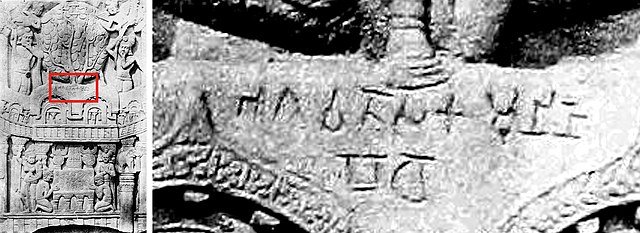
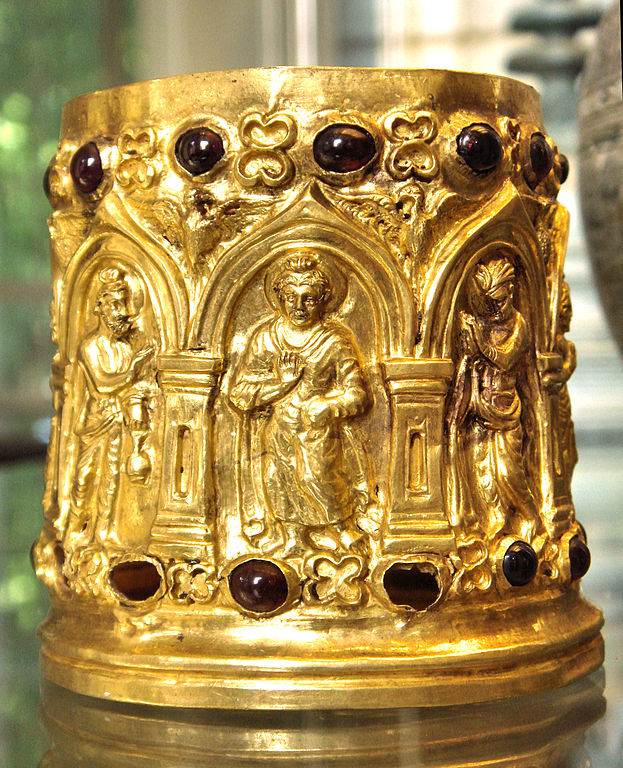
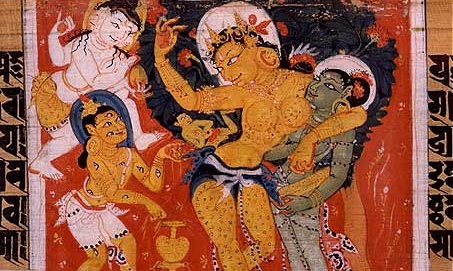
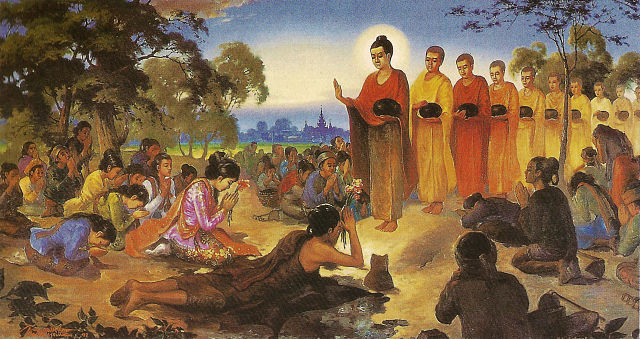
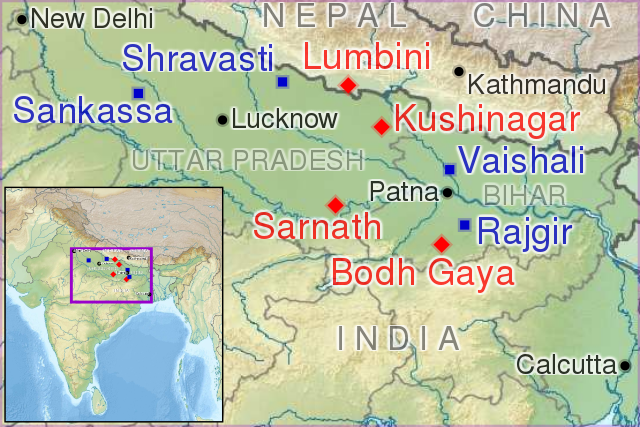
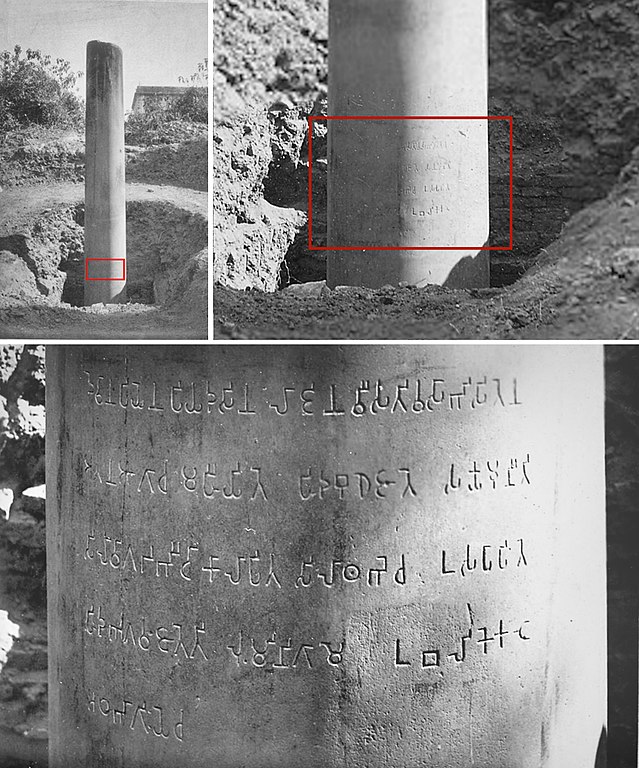

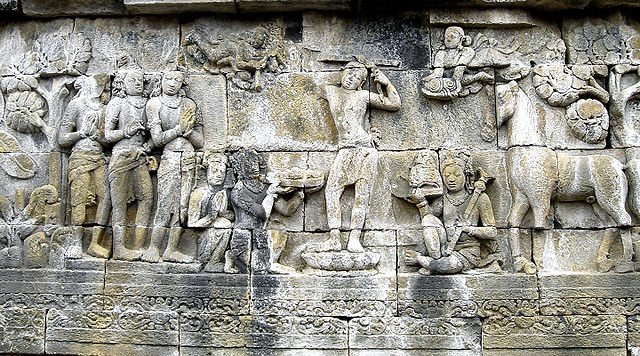

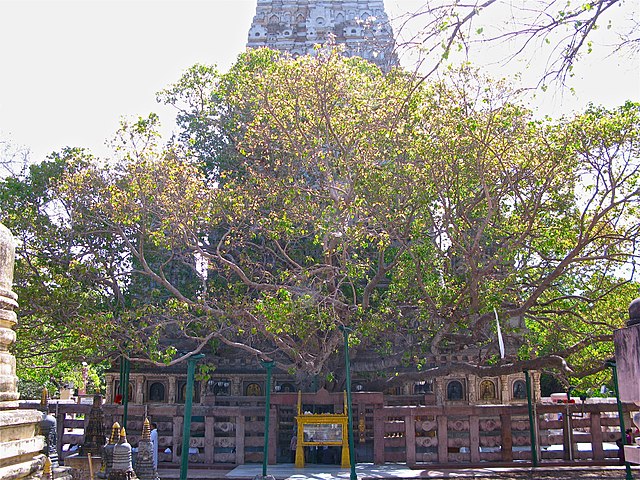
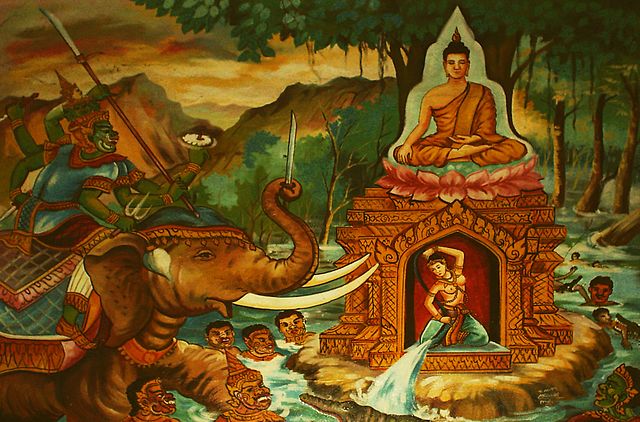
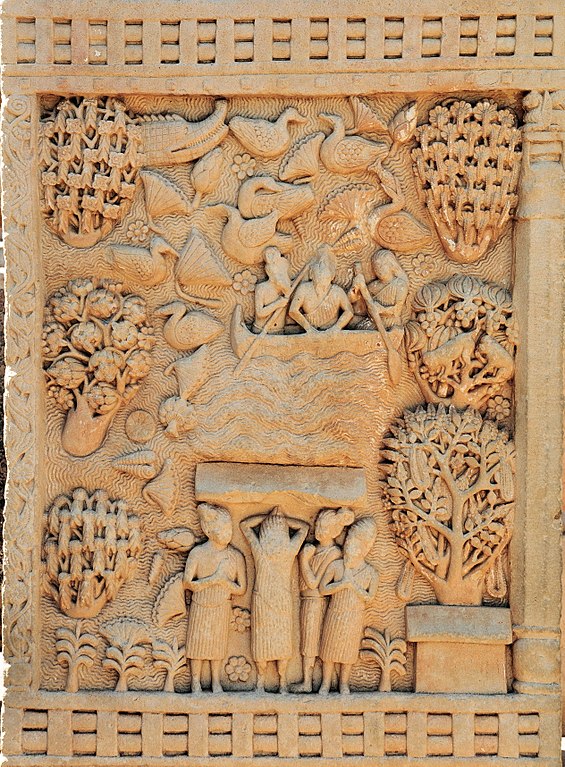
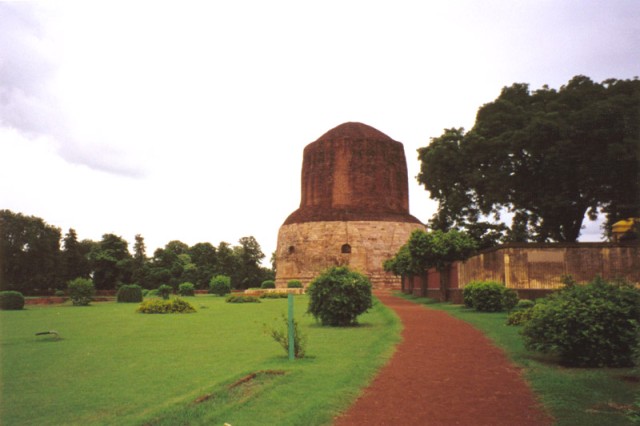
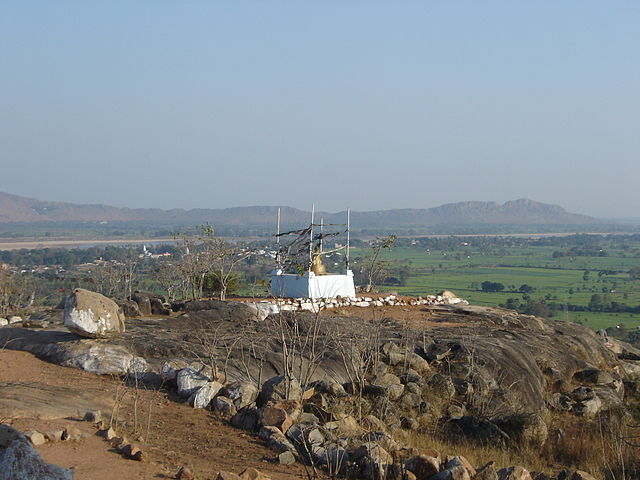
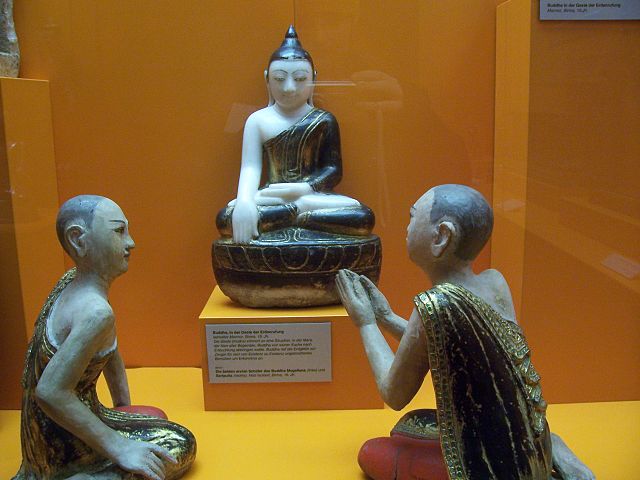
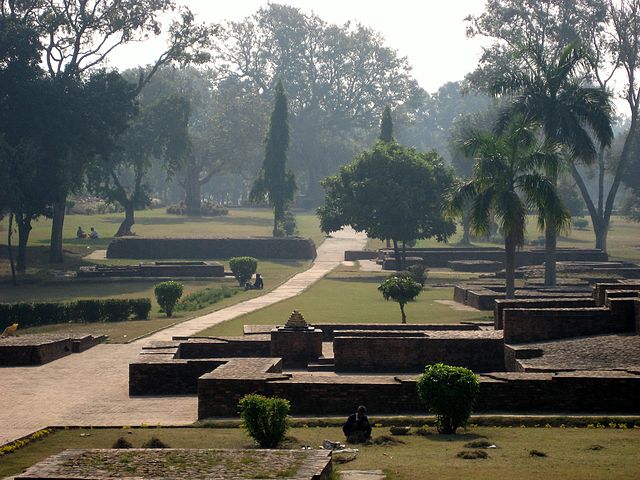
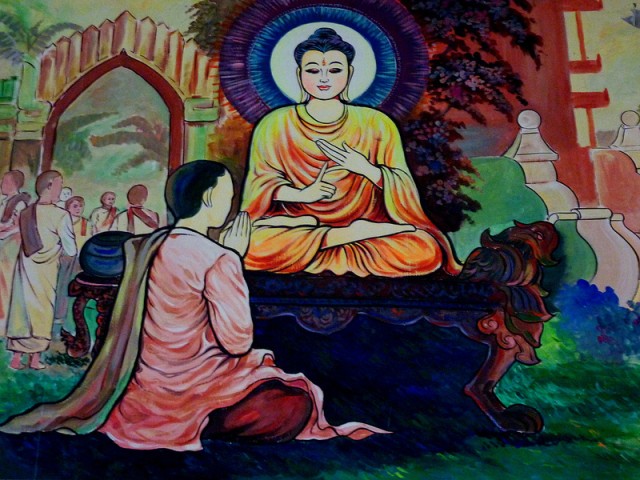
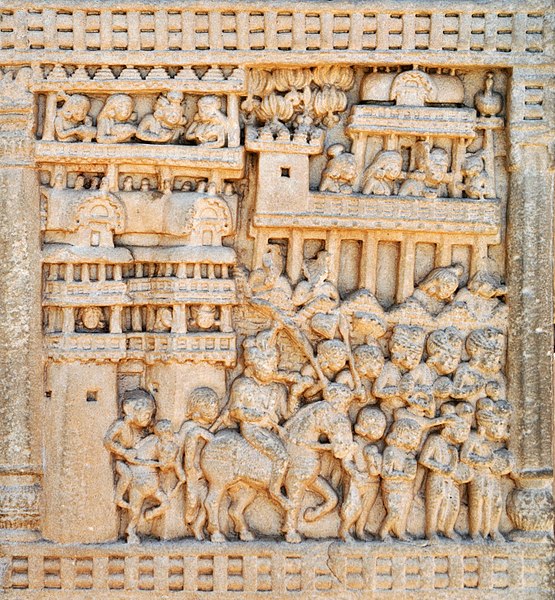
.jpg)
.jpg)
,_Gandhara,_3rd_or_4th_century_AD,_gray_schist_-_John_and_Mable_Ringling_Museum_of_Art_-_Sarasota,_FL_-_DSC00.jpg)
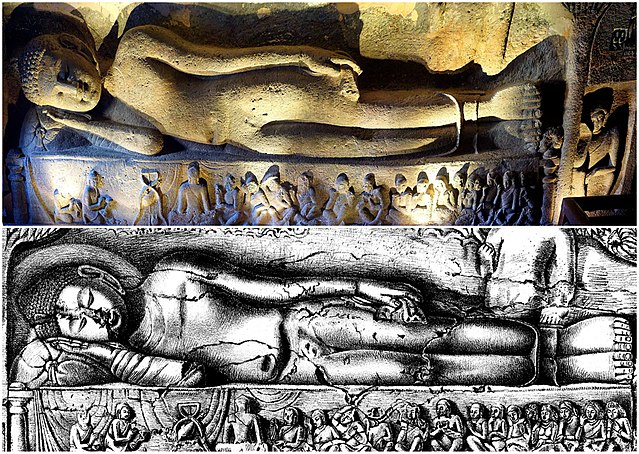
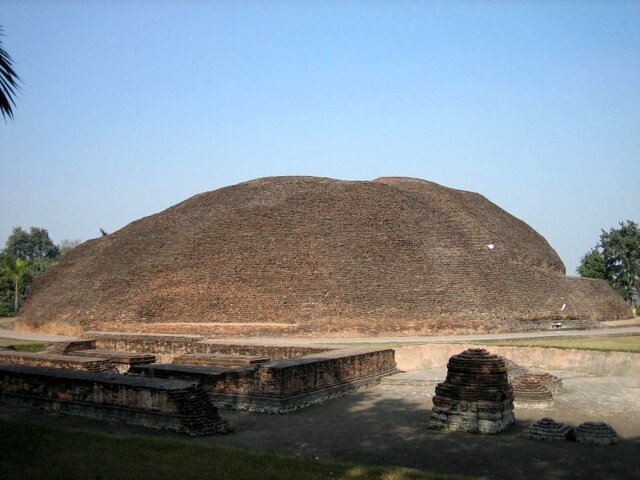
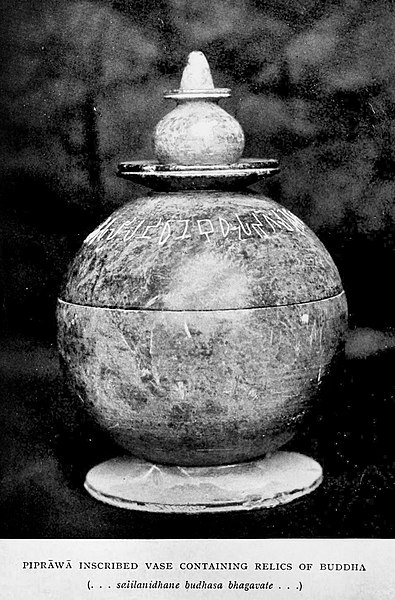
.jpg)
,_part_31_-_BL_Or._14915.jpg)
.jpg)
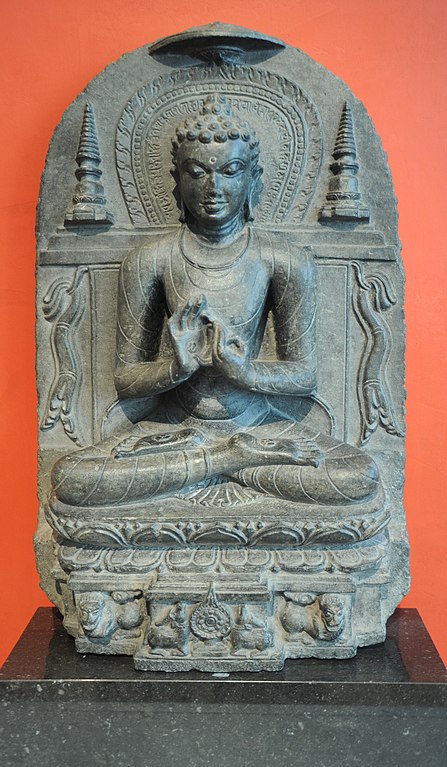
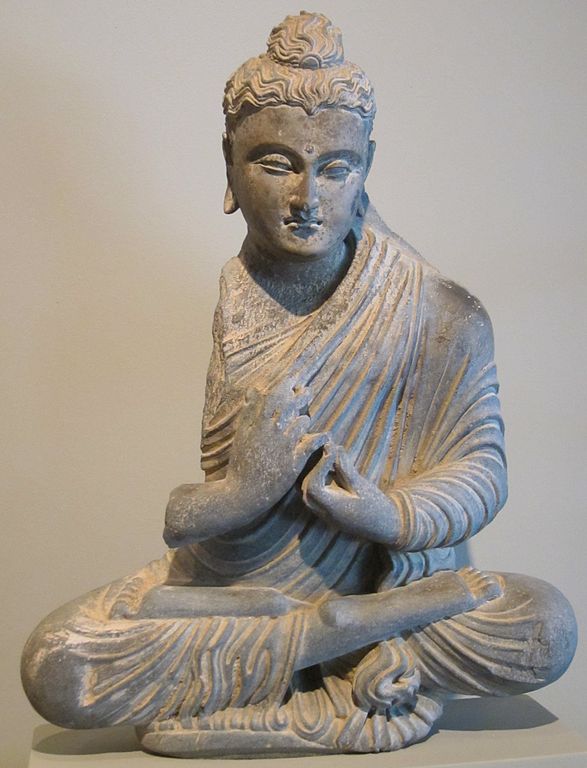
.jpg)
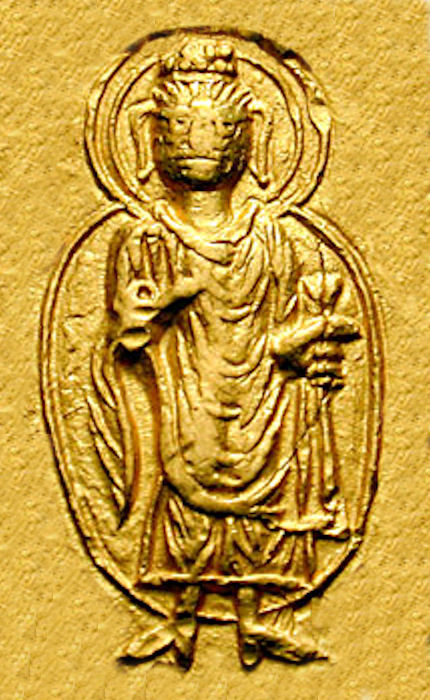
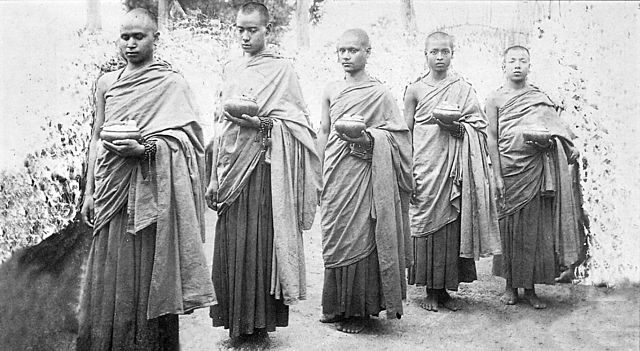
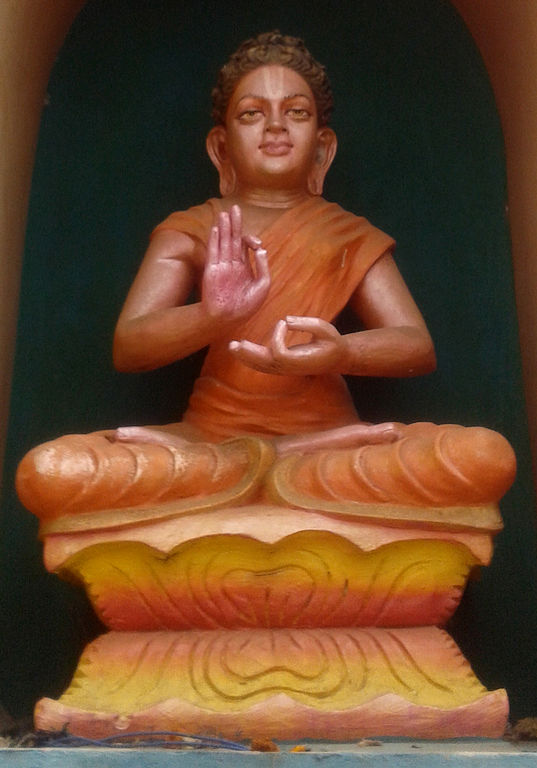
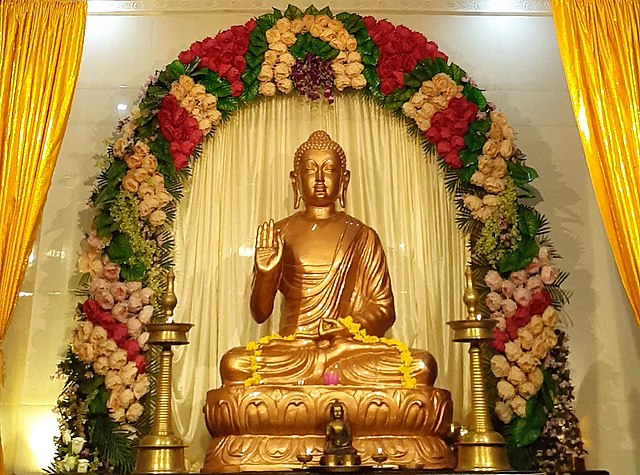
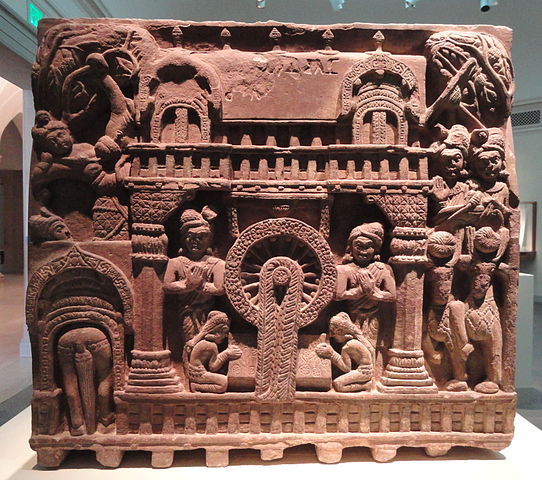
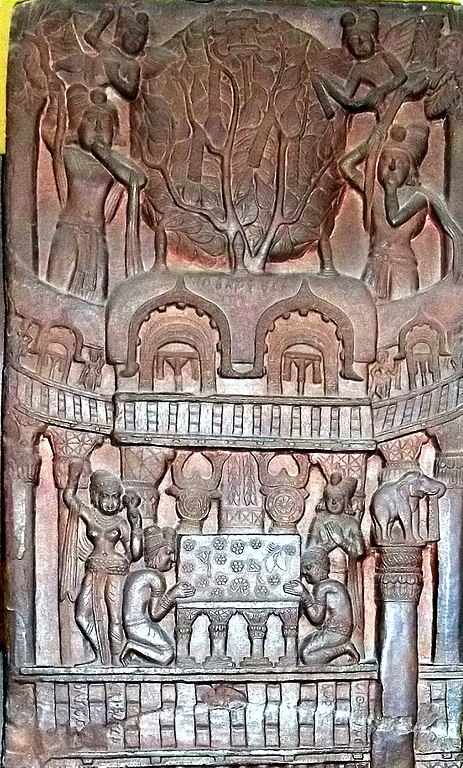
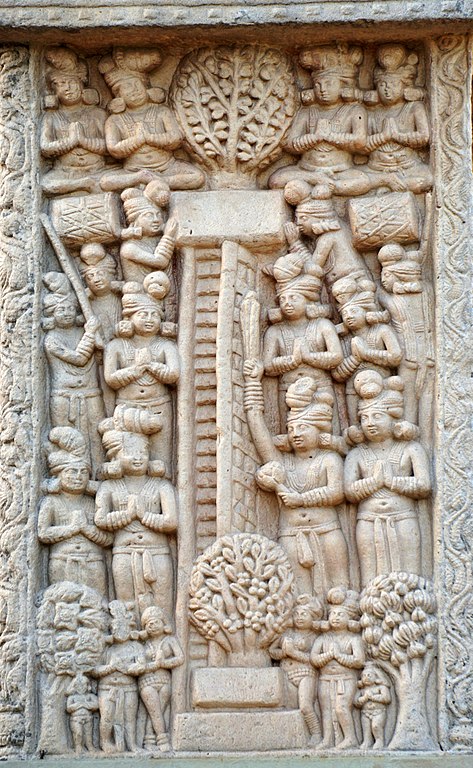
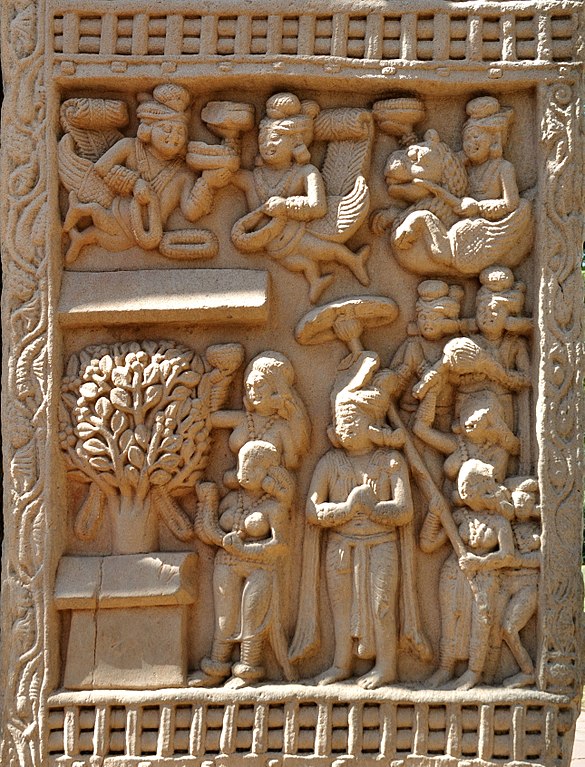
_at_Rajagriha,_the_visit_of_Bimbisara.jpg)
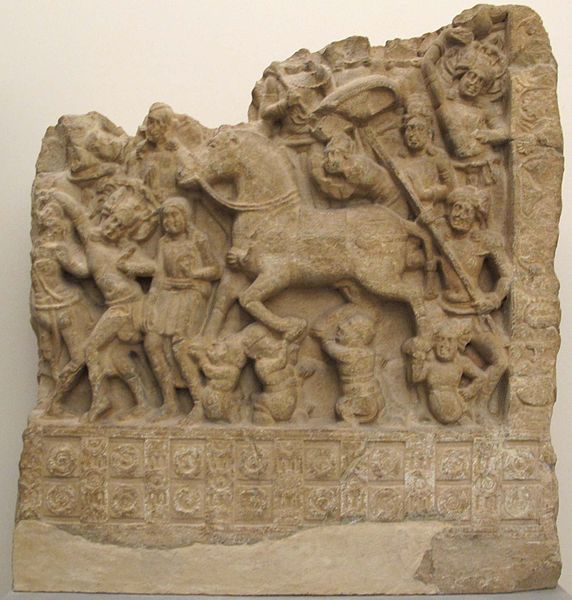
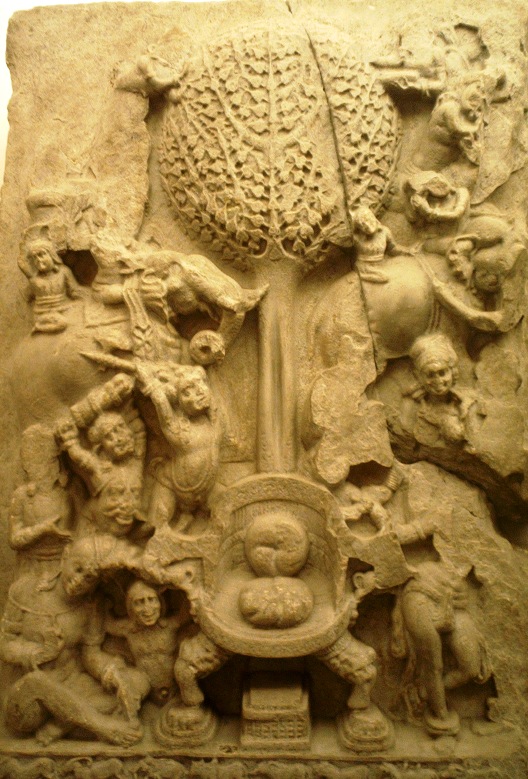
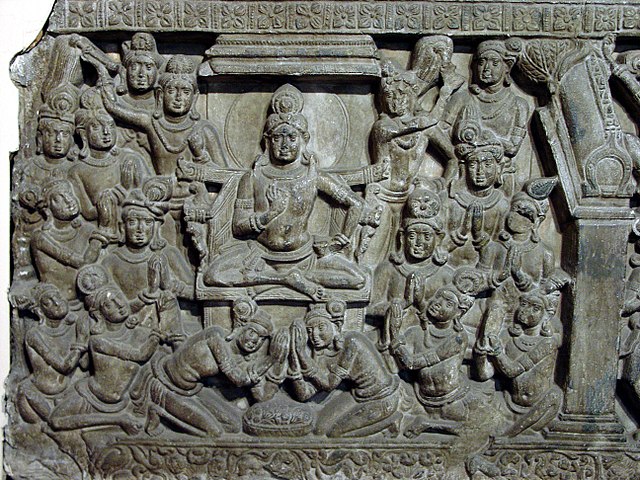
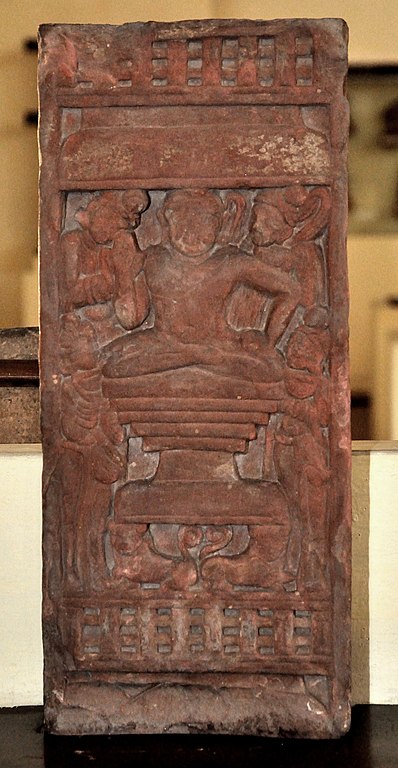
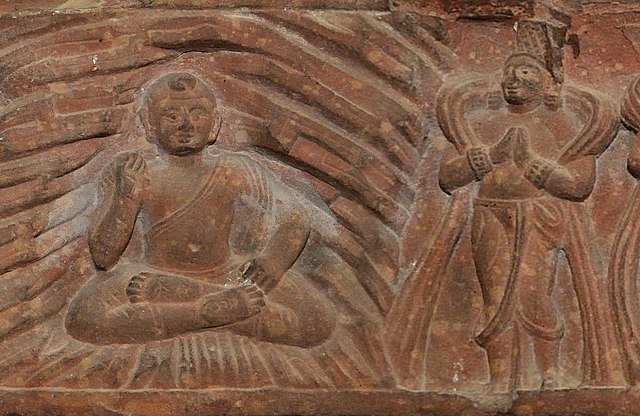
.jpeg)
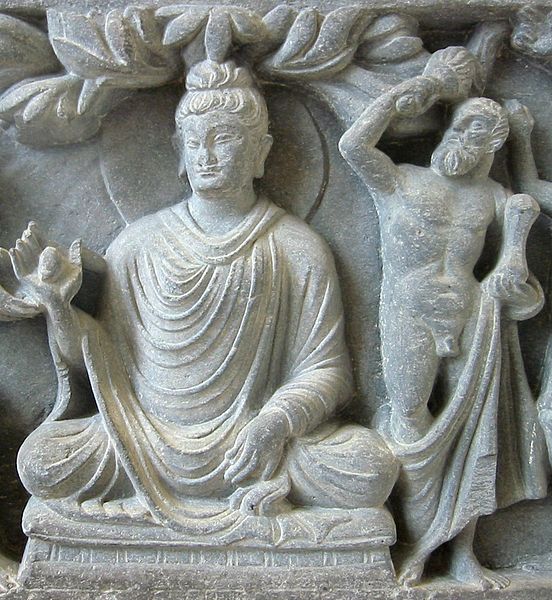
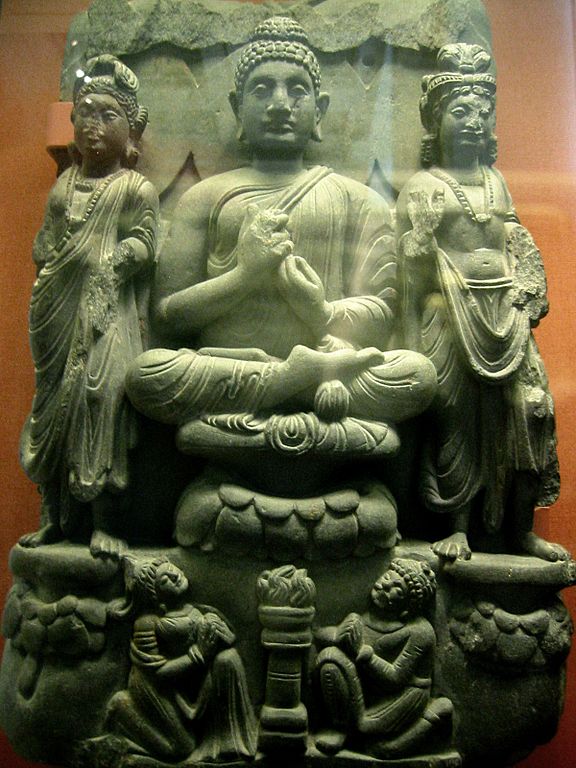
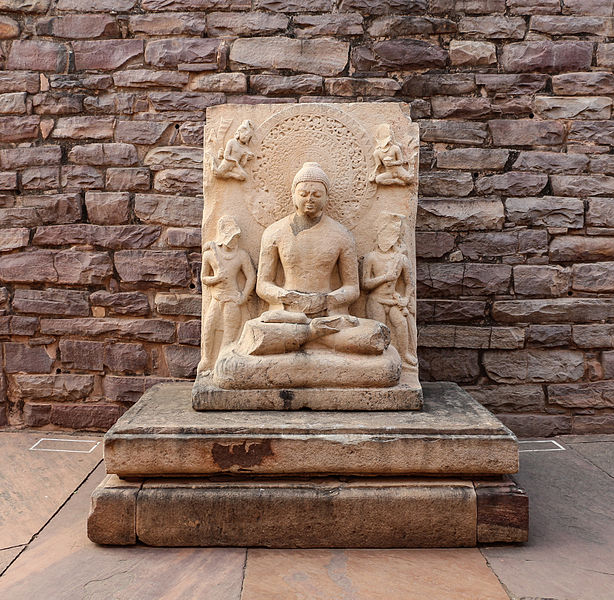
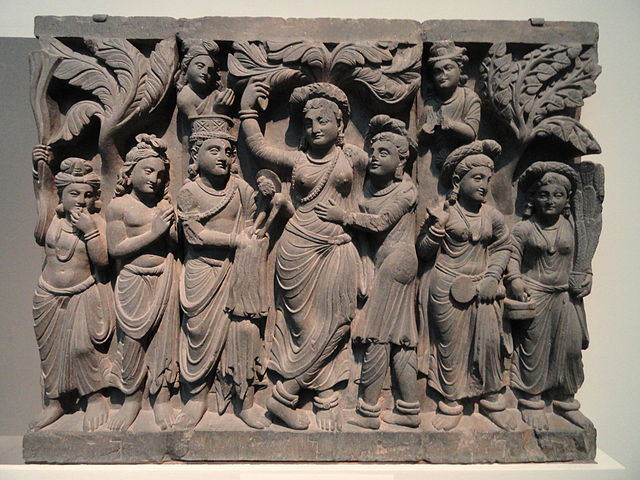
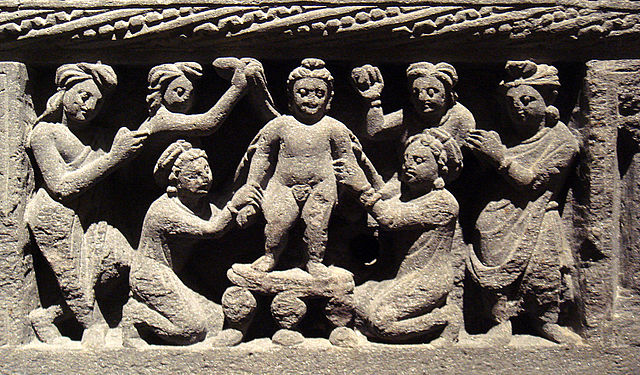
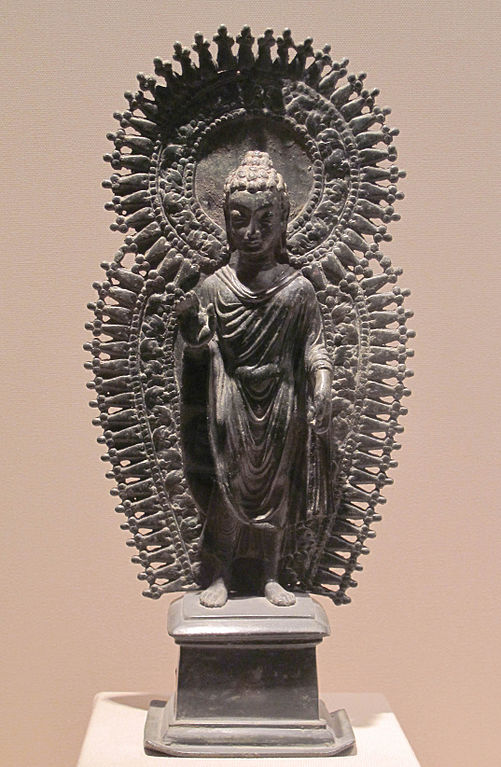
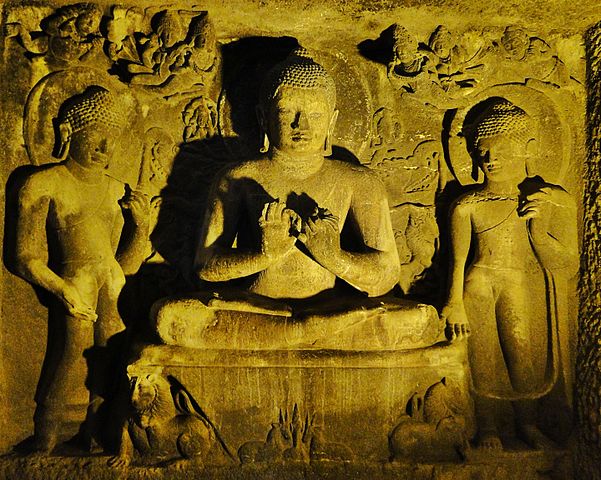
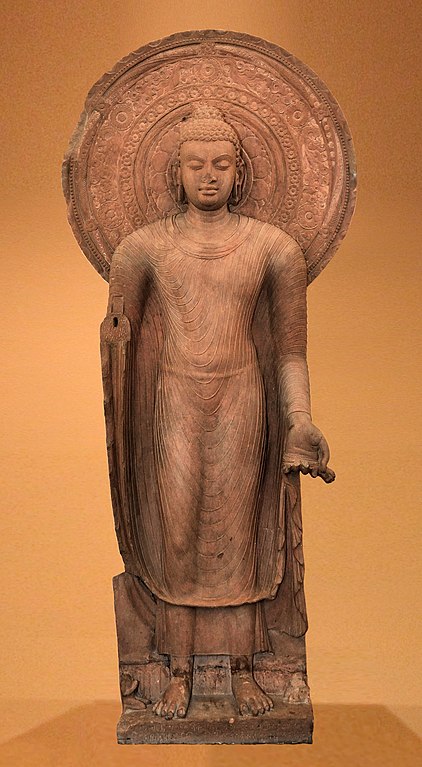
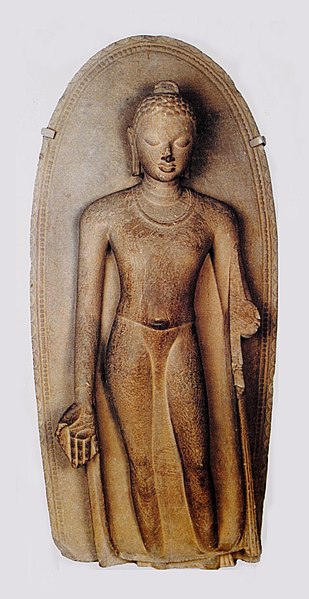
.jpg)
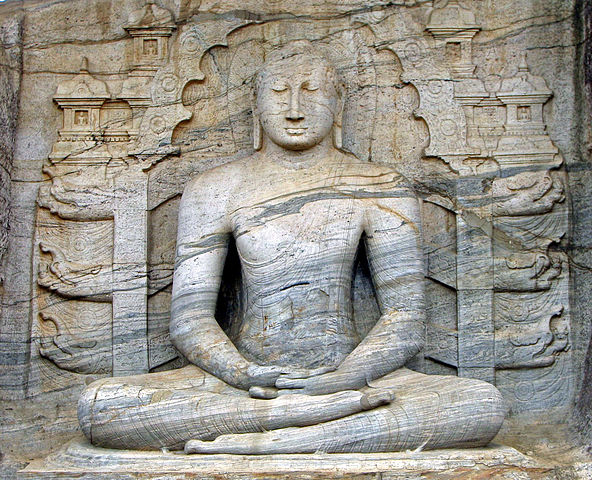
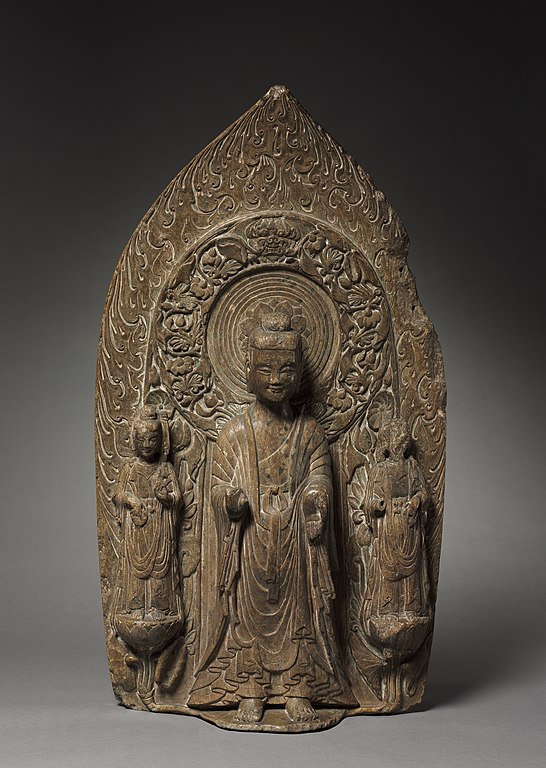
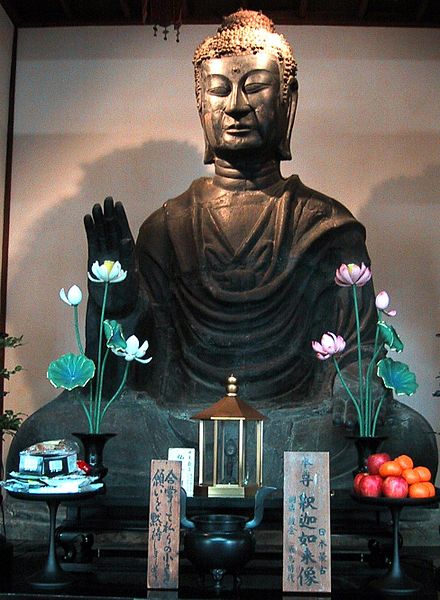
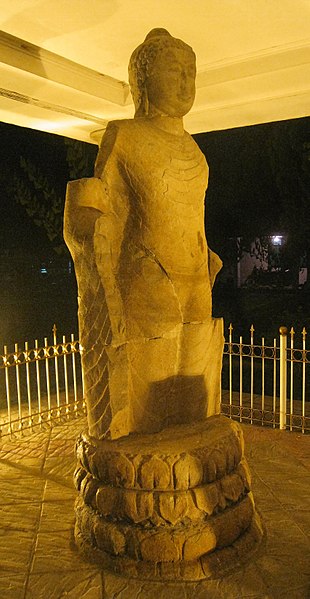
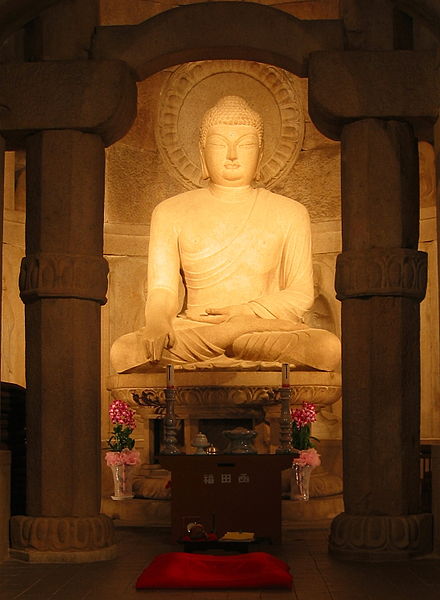
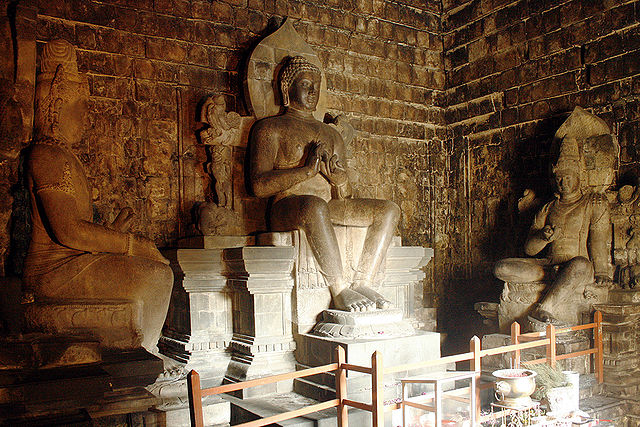
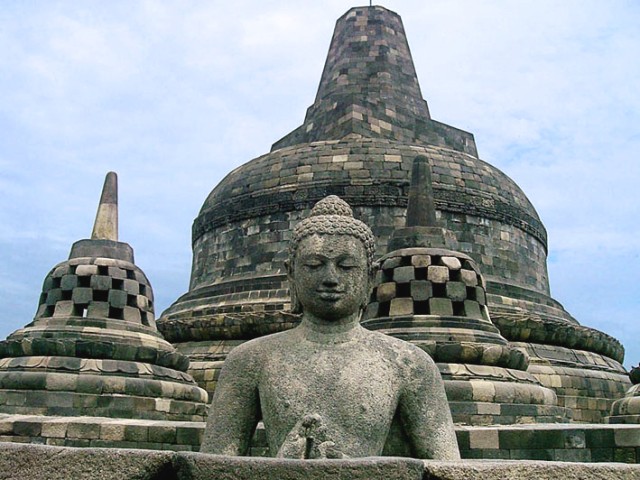
.jpg)
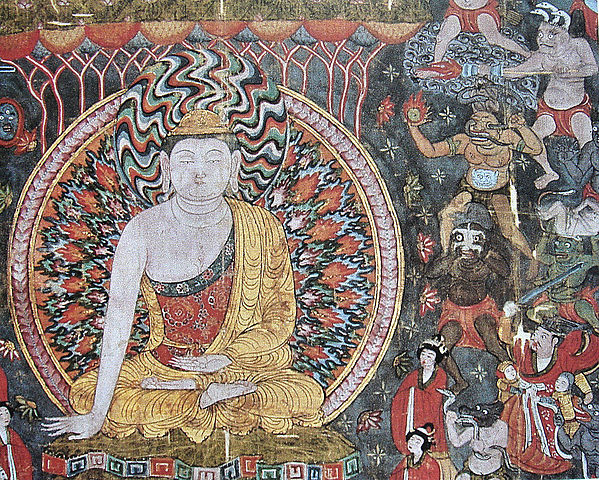
.jpg)
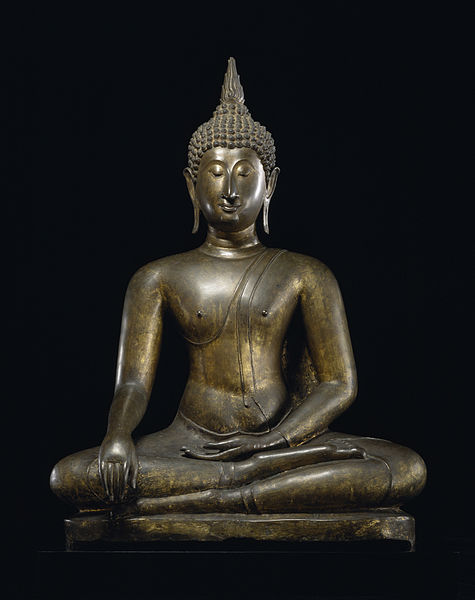
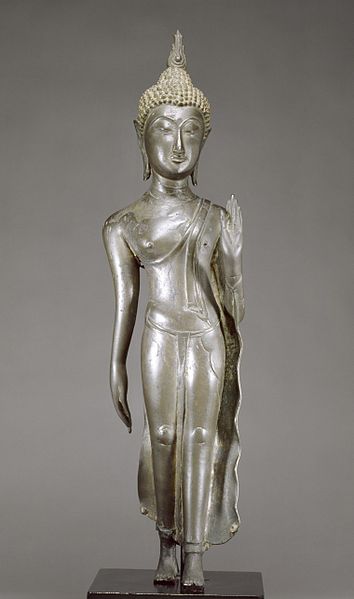
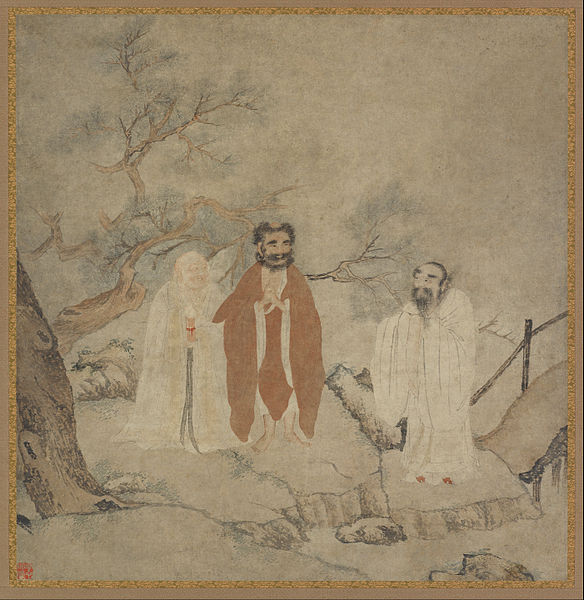
.jpg)
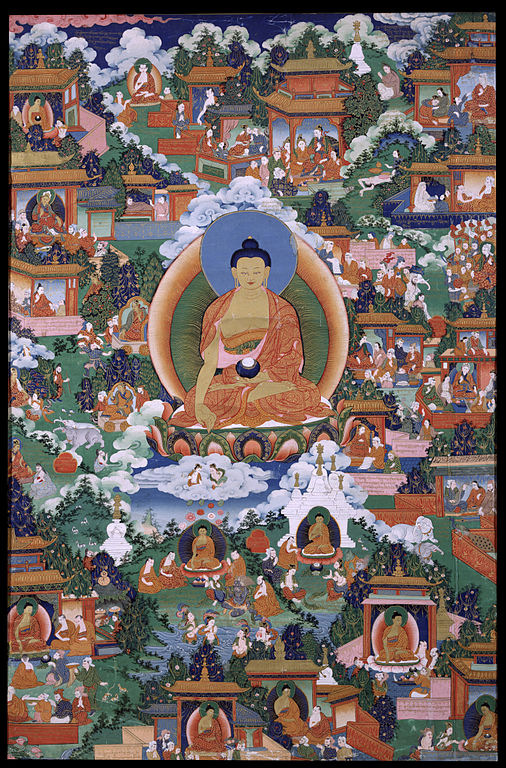
.jpg)
